The following Articles and Images have been added to the database
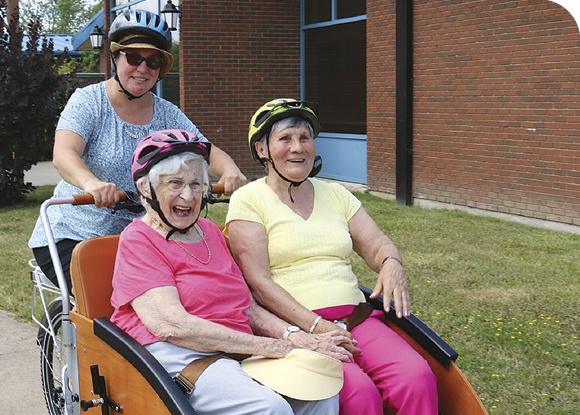
With support from Lanark County Council and several local businesses, Cycling Without Age Lanark County (CWALC) has taken the next step by launching a $7,000 crowdfunding campaign with the goal of purchasing its first trishaw.
For those not familiar with the movement, Cycling Without Age (CWA) started in Copenhagen, Denmark in 2012 and has spread internationally to 50 countries with 2,200 local chapters (as of March 2020). Special three-seat electrically-assisted bikes called “trishaws” allow volunteer cyclists called “pilots” to provide free rides to the elderly while building friendships. Worldwide, CWA has 33,000 trained pilots and has served over 1.5 million people.
In a 2017 study conducted at the Saint-Louis Residence in Ottawa, pilots observed the following responses from their passengers: “sang O Canada; laughed a lot; loved the sunset; waved to everybody; smiled the whole ride; happy; laughing and stomping her feet; loved the fresh air; loved the beauty of nature; yelled ‘woohoo!’; felt relaxed.” CWALC aims to bring this experience to residents of Lanark County’s seniors’ homes.
“There is no doubt that our elderly have been hit the hardest by the COVID-19 pandemic. From those who live in seniors’ residences fearing the next outbreak to those who have contracted the disease facing a higher risk of mortality, this is a difficult time for the eldest among us. Taking an elderly resident for a ride in a trishaw will be a great way to show we care once the pandemic restrictions are lifted,” says Treff Peters, Lanark County CWA affiliate.
CWALC is partnering with the crowdfunding platform Wayblaze for this campaign. “We chose Wayblaze because it targets Social Inclusion, Health and Wellness projects in local communities,” Peters adds. Donations can be made at <wayblaze.com/cwalc>.
For more information, please visit the Cycling Without Age Lanark County Facebook page or <cwalc.org>. For further details about the CWA movement, please visit <cyclingwithoutage.org> and <cyclingwithoutage.ca>.
Back when COVID-19 was just a gleam on the social media horizon, Rob and I listened to an intriguing podcast while delivering the February issue of theHumm. Presented by The Long Now Foundation, it featured author and life-long techie Tiffany Shlain talking about her new book 24/6: The Power of Unplugging One Day A Week. In a nutshell: “Every Friday night, we all unplug from all of our technologies and don’t turn them on again until Saturday evening. Unplugging for a day makes time slow down and makes me feel more present with my family. I not only appreciate this quality time with them, but it has also made me appreciate technology in a whole new way.”
We decided to embrace our own tech shabbat, and now try to unplug for as much of every Saturday as we possibly can (not having a land-line makes it tricky, but we are careful to eschew emails and social media when we must make a call or answer a “what should we bring” text from someone we have invited for dinner… back when we could invite people for dinner). We replace our phones and tablets with books, magazines and the crossword page of the Saturday paper, and swap Spotify for our old CD collection. No movies — just dinner parties for us (back when we could invite people for dinner…). We were doing fairly well at it until our world turned upside down in mid-March.
But then, amid the exponentially increasing clamour about stats, safety and physical distancing, we gamely put our devices aside once again. And the effect was even more pronounced — even more of a balm for our social media-overloaded souls. Because of the profound effect that shabbat had on us, we have committed to continuing our practice even (or perhaps especially) throughout this tumultuous time. And whether you settle on Screenless Sundays, Minimal Media Mondays, or I-just-can’t-take-it-anymore Wednesdays (sorry, couldn’t come up with any alliteration there), I highly recommend checking it out. You may not be able to have anyone over for dinner for a while, but you can always call a friend!

Welcome back to the print version of theHumm! We are thrilled to return to this format, and we sincerely hope that this issue finds you well. As you might imagine, it is a bit different from our past issues — most noticeably because there is no calendar (aside from the teeny one over at the right) and few articles about upcoming arts, cultural and community happenings. Essentially, almost all the events we normally promote and preview are undergoing a dramatic shift — cancelling, postponing, moving online.
To help connect you with everything that IS happening, we took the opportunity to enhance theHumm’s online presence over the past few months. You can access (and share!) all of the articles at <thehumm.com>, and if you follow us on Facebook you’ll get up-to-date information about anything that comes across our desk. In addition, we have launched a new weekly e-newsletter called Hummail. In it we interview creators, innovators, volunteers, movers and shakers; show you where you can go to support local artists; and share information about upcoming events. No gloom or doom — just a celebration of the “creative buzz” in the Ottawa Valley. Please visit our website and subscribe!
Our amazing columnists and contributors have been stalwart — sending in columns for our two online-only issues and filling this one with stories of hope, helpfulness and creativity. And at the risk of being corny, we are really proud of this month’s PRIDE feature!
We would also like to thank all of the local businesses that are advertising in that issue, which is what is allowing us to bring theHumm back in print format. We normally rely more heavily on advertising from event organizers, but in these challenging times they can’t yet commit to anything and many of the bigger festivals and events have been cancelled right through to the fall. So it is small independent retail and service businesses as well as local artists and artisans who are bringing the June issue to life, and they need your support more than ever. Please patronize them if you are able, and please consider supporting theHumm by telling our advertisers that you saw their ads in our paper. Thank you! Stay safe, and be kind.

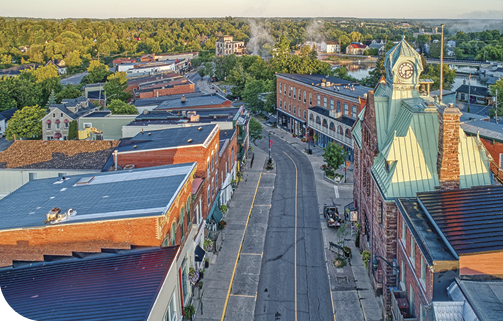
John McQuarrie is a photographer and publisher of the recently released book Almonte, Spirit of Place. We contacted him to find out how his most recent book came to be, and how the current lockdown is affecting its reception in the community.
theHumm: Your photos are stunning — can you tell us a bit about your training and background?
John McQuarrie: Like many working photographers, I simply consumed print and online tutorials along with each advance in imaging technology to continually add new tools to my skill set over the years. In the process I found that the diverse elements of the areas I studied continually built upon each other in a way that worked beautifully. As my almost 50 published photo books will reflect, each one is just a little bit better than the last, but the learning never stops. I would also like to point out that, unlike the “olden days” of film, our new digital world of imaging tools has changed the face of photography to the point where those JPEGs that move from your cameras to your computers are only the starting point for your special photographs. That digital file you created has a lot of your work hidden in those pixels that can be made to reveal details you saw when you pressed the shutter button but do not now show up in your image. People often ask me what percentage of the images in my books are “Photoshopped”. The answer is “100”.
Your approach is to take the photos and then to find local writers to do the wordcrafting — what are the advantages of this collaborative approach?
As you read the wonderful stories written by your neighbours and friends, stop and take a moment to imagine all that this book would have lost without their heartfelt contributions. Flat and one-dimensional comes to mind.
So yes, the oldest colour images in Almonte, Spirit of Place were taken on July 26, 2019. And the story of my first ten minutes appears on the front cover flap as follows: “It had been some time since it happened. Talking here about a simple ‘smitten at first sight’ experience. It was early on the morning of July 26, 2019 when I first visited Almonte. Approaching along Main Street, the view through my windshield suddenly flipped from ordinary to extraordinary the moment I crested a hill, heading down to a river that had to be the Mississippi — then, on my left a stone flour mill beside a pedestrian bridge crossing the river to downtown. Next, an aged white powerhouse, and another old mill with a tantalizing series of staircased residential terraces overlooking a steaming waterfall. A left turn onto Mill Street was impossible to resist, and a spell was being woven as I drove slowly up and through this 19th-century dreamscape. In very short order, a red light offered a few seconds to decide on the obvious necessity of a left turn. Good things happen when advancing downhill on ‘Bridge Streets’ everywhere. What I soon discovered was the Old Town Hall on the river, and a parking lot that demanded yet another left turn. A rising sun was warming the tops of some of the buildings around me, and I knew in that moment that a book was being born. And, of course, you now hold in your hands the offspring of a love affair.”
Later that morning I made a long-anticipated visit to Mary and Terry Lumsden at Mill Street Books and they outdid themselves, from the moment I introduced myself. One of the first of their recommendations was that I connect with Millstone News and theHumm. Best advice that ever came my way! And much of my good fortune in the process of building this book started in their shop.
How does it help to have someone “from away” see and show the area with a fresh perspective?
For this one I will defer to Mayor Christa Lowry and her lovely and most-flattering Foreword that speaks to this point, an excerpt from which follows here: “While John’s photography is truly a work of art on its own, what makes his book such a treasure is how he has woven stories from the people of Almonte, Blakeney, Appleton, Clayton and Pakenham into the pages. Not only does John’s photography itself provide unique angles, depth and dimension, varying perspectives are also articulated from the quotations and stories included from the people who live here. While his spectacular photographs are of landscapes and architecture, the actual story John tells is about people and community. Like when returning home ‘from away’, John’s stunning work has given me yet another lens to see my community from new angles. I thank you whole-heartedly, John, for sharing your striking perspective of our beloved home.” —Christa Lowry (March 2020)
Her roots are over 200 years deep and she answers your question perfectly. As a photographer I look for warm light shining on beautiful places that show off their “best sides”. I don’t need to know much of anything about them to do this reasonably well, but doing the words is for people living in the “256”.
Why did you choose Almonte, and where are you thinking of heading next?
It was more like Almonte chose me! By mid-summer of 2019 my Toronto, Spirit of Place (coincidentally, also with a foreword by another mayor, John Tory) was launched and distributed in the GTA and I was beginning the design of Vancouver, Spirit of Place. Normally my workflow is to make photographs in the spring — summer — fall and do the designs in the winter. So I was craving a little shooting. I had always been attracted to Lanark County so decided to do exploratory shoots in Carleton Place, Perth and Almonte. Started with Almonte and never left. I felt like the proverbial “kid in the candy store” and I could eat all I wanted. But those other two towns are still on the table.
Your press release includes this quote from Mason Cooley: “Books give us someplace to go when we have to stay Home.” How do you think the current situation is affecting the book’s reception?
The book’s rather robust reception has been a most encouraging sign for us, and the sentiment reflected in Cooley’s quote (c.2000) seems to resonate now, particularly, in the midst of our current situation. People have to have hope, and a book like this, which shines a light on the extraordinary community this place is, will perhaps help to put a hopeful face on just how much we have to look forward to when we get to the other end of all this.
What are you personally most concerned about during this pandemic?
Apart from all of the obvious fear and tragedy, my biggest hope is that the new normal that must follow will be as close as possible to the old. And there can be no doubt that our experiences now will make everything in our futures taste better. Of course, a vaccine would be a nice condiment.
What are you optimistic about in terms of what happens to our community (or perhaps specifically Canadian authors/publishers and local bookstores) during and after the pandemic?
For the book business in general, I have seen a growth in the challenges since 2008 that makes me work a little bit harder every year and I have adjusted my workflow accordingly. My new interest in looking at smaller communities like Almonte is certainly encouraged by this book’s success, right out of the gate.
And for your community, I have to be optimistic when I see your appetite for arts and culture, the value you place on supporting local businesses, and your unbridled enthusiasm for the place you call home. I love your chances.
You can order this glossy 152-page book now from Mill Street Books by calling 256–9090. Mary and Terry will donate 10% of the book’s sales to the Almonte General Hospital.
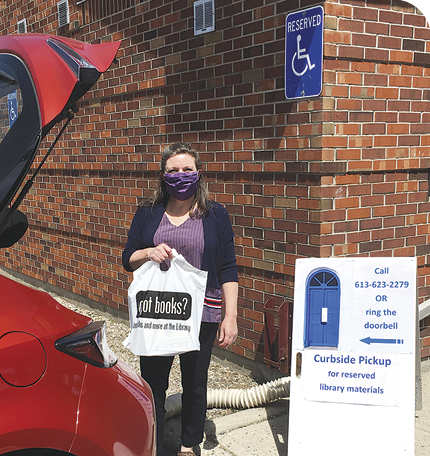
The past few months has certainly been posing a challenge to readers everywhere.
For some it has meant exploring those long-forgotten books neatly displayed on bookcases at home. For others it has meant exploring new ways to read with the help of your local library. For years, your membership card has had the magical powers of being able to access free eBooks. Recently, many have discovered a whole new vocabulary of online platforms — Hoopla, OverDrive, Libby and TumbleBooks, among others. Your membership goes beyond eBooks to include digital magazines, movie streaming, audio books and more. Showcasing these resources has been our silver lining to the cloud of shuttered libraries.
Since mid-March, librarians have been busy behind closed doors ensuring the Virtual Library is easily accessible to all our patrons. We’ve also been inventive with online storytimes, podcasts and conference calls to ensure that everyone stays connected to their community libraries.
As we all navigate the new normal of service delivery, the first glimmer of traditional access is the introduction of curbside pickup and deliveries of reserved library materials. This will be particularly welcome news for those who do not have access to the Internet at home and for whom this uncertain time has seemed even longer without the usual stacks of books, magazines and movies.
We understand you miss the physical contact with your library and all of the resources within its walls. We, in turn, have missed all our visitors: the regulars who come to socialize, share a laugh, support our programs and use the computers; the new patrons we’re just getting to know; and the ones who drop in once in a blue moon.
The community hub model of the modern library will change in this new reality, but all libraries are rising to the challenge to keep the doors to literacy, learning and social interaction open for everyone.
Regional Reading Round-Up
Since things are still changing and new safety policies are in place, here’s where you can find out what services your local library is offering and how to access them:
Almonte: <missmillslibrary.com>, 256–1037
Arnprior: <arnpriorlibrary.ca>, 623–2279
CP: <carletonplacelibrary.ca>, 257–2702
Lanark Highlands: <lanarklibrary.ca>, 259–3068
Pakenham: <missmillslibrary.com>, 256–1037
Perth: <perthunionlibrary.ca>, 267–1224
Renfrew: <renfrew.ca/library-welcome.cfm>, 432–8151
SF: <smithsfallslibrary.ca>, 283–2911by Karen DeLuca
Following a national trend, business at local bike shops is booming.
“A hundred percent, absolutely,” says Pete Wood, owner of Heritage Bikes in Perth. “A lot of people are finding that they need something to do, get some exercise, and bikes are a perfect way to be able to do that.”
Since March, Heritage Bikes has sold a whole lot of bikes. Pete says: “there has been a real run on kids’ bikes,” with one customer driving from Toronto to Perth as Heritage Bikes was the only shop in a 300-kilometer radius that had the product they were looking for.
As warmer weather has arrived, adult bikes have sold well too.
“There’s also a lot of interest in a very utilitarian bike,” he says, noting that before the pandemic, people often came to Heritage Bikes wanting a very specific race bike or a very specific mountain bike. But that has changed. “Now people just want a commuter, an urban bike, a simple bike under $1,000.”
“We’ve gone through all of our used bike sales,” he adds. “Now we’re into very comfortable hybrid bikes, so it’s almost a European feel to the choice of bikes people are making.”
Bill Barrie, who owns Almonte Bicycle Works, says he’s been busy too. Not so much with selling new bikes, but repairing and restoring people’s older bikes.
“However, sales of e-assist bikes are definitely up,” he says. “Most new owners are buying online and then bringing them to me for assembly and tune-up.”
Almonte Bicycle Works has been closed to the public since early March, but Bill has been extremely busy servicing bikes by appointment. He has also sold many used and refurbished adult and children’s bikes, with all proceeds to a charity.
Busy working twelve-hour days on assembly, repairs and restorations, Bill says he hasn’t needed extra support for his business during the pandemic. “All I need is a vacation!” he jokes. “It has possibly been my busiest spring in ten years and I’m exhausted.”
Pete and his staff — of two other employees plus, in recent months, an extra mechanic — have been similarly swamped. One thing that’s worked very well at Heritage Bikes has been taking orders by phone and being able to fit people — according to their height, arm length, and inseam, for instance — with bikes very quickly. They’ve been able to do this well, Pete says, because his bike-loving staff are experienced and extremely knowledgeable about industry standards.
They have had to change the way they do business, however. “We’ve had to initiate a lot of different protocols,” Pete says, noting they have been spraying bikes down for customers, keeping a ten-foot distance, and wearing masks when dealing with the public and with one another.
But good things have come from these trying times as well.
“The Top Shelf Distillery put something really nice out there for businesses around Perth,” Pete says. “and that is that they’ve offered eighty percent alcohol spray and a box with a whole bunch of other things, and that really was a generous gift. Thing is, it’s assured us of buying more of the same product.”
Both shop owners have seen a lot more families taking to the roads on bikes this spring.
“I’ve had many, many locals dusting off unused bikes or looking for a used bike suitable for the [Ottawa Valley Recreational] Trail,” Bill says. “It’s the best way to escape from the ever-increasing and often disrespectful traffic on local roads. Especially for families with young children.”
At Heritage Bikes, Pete has seen similar trends. “There’s been a real uptake in the concept of a gravel bike,” he says. “That’s a bike that looks a little like a road bike but it’s got a lot more wheel base and it’s a little more stable. These people are getting on to those back gravel roads. But I think that the trend specifically right now is just having an urban bike, and people are looking not to ride huge distances but to be able to ride with their family and be in a really safe place for that.”
He thinks that side streets and secondary roads are safe for that too, especially with fewer vehicles than normal on the road.
Both bike shop owners hope more people keep cycling after the pandemic, as a hobby and as a form of transportation. More people are keeping active because they’re cycling now, and many are driving less, particularly in larger cities.
“It turns out that eighty percent of the commuting people do is within about a five kilometer radius and that’s very doable, to hop on a bike,” Pete points out. “And the other thing is that if I’m just hopping on my bike to go to the grocery store to get a couple of items, between me stepping into my car, starting the engine, driving, parking and all those other things, it would be just as fast if not faster on my bike, even though it’s about two kilometers for me to go to the store.”
Fewer cars on the road, of course, means less pollution.
Far too often, people with disabilities can be excluded from healthy trends like this uptick in cycling, but Pete says technological advances in certain bikes are helping to include more people. “Disabilities are interesting. They come in many different forms,” he says. “And e-bikes are a really wonderful way that people are leveling the playing field.”
For instance, people with mobility issues who can cycle often find themselves “completely exhausted” during or at the end of a bike ride. “But e-bikes are taking care of a lot of those issues,” Pete adds.
Special adjustments can be made to bikes to fit an individual’s special needs too. Recumbent e-bikes, which feature two wheels at the front, one at the back, and an adjustable, comfortable seat with a backrest, are wonderful for some people with disabilities, Pete notes — and like other e-bikes (or “pedal assist” bikes), they are an ever increasing choice of consumers.
In his Almonte shop, Bill has also seen the uptick in people choosing e-bikes.
“I’ve sold and repaired quite a few adult trikes over the years,” he says. “They can be a saviour for those with balance issues. I’ve also customized many bikes to accommodate a variety of disabilities.”
Ken Rose, who owns Lake Effects and lives in Westport, owns an electric recumbent bike and he says it’s a thrill to ride. “The bike is the love of my life and my drug of choice,” he says. “When I get out on it, I feel like a teenager.” He says he has enjoyed riding for a few hours each day, especially during the pandemic. “The bike is so comfortable,” he says. “It’s fun and thrilling.”
“Trails are my preference,” he adds, “but I ride after dark on Westport’s abandoned streets with lights ablaze.”
When Shirley Fulton-Deugo, owner of Fulton’s Pancake House & Sugar Bush, got together with the team from Almonte’s Dairy Distillery, little did she know great things were in the making. Great things such as the launch of the Dairy Distillery Maple Vodka Cream Liquor, but even more wonderful — a chance to help out her local community facing a world-wide health crisis in COVID-19.
In February of 2020, Jonny Crozier from Dairy Distillery asked if Fulton’s would be interested in supplying maple syrup to produce a Maple Vodka Cream Liquor. Jonny sampled various grades of syrup and later that month started producing the new product. It was a hit, and each batch sold out quickly! Plans for more production were put on hold, however, when they turned their focus to produce much-needed hand sanitizer in light of the COVID-19 pandemic.
Fast forward to March 20, three days after the mandatory Pancake House closure and abrupt end to the traditional maple season. Fulton’s received a call from Claire Mills at Dairy Distillery to advise they wanted to share the profits of the Maple Cream sales 50/50 with Fulton’s. Shirley was absolutely speechless, and the tears flowed. With much gratitude, Fulton’s accepted the generous cheque of $1500.
Fulton’s decided to pay this generosity forward and gave the cheque to 6th generation family member Madeline Downey, in support of her new business, The English Pie Shop. In turn, Madeline promptly focused her attention on the community, purchasing supplies to make $1500 worth of savoury pies that continue to be donated to this and surrounding areas. Her delicious pies and cakes are made in the kitchen of neighbouring family business the Cedar Hill Christmas Tree Farm. Visit <facebook.com/theenglishpieshop> for details on how to purchase.
Fulton’s always donates the contents of the “Pay It Forward Jar” (loose change donations from very generous customers) back to the community. This year, it was decided to complete the circle of giving, and $225 was sent to Dairy Distillery to purchase hand sanitizer for front-line workers at the Lanark County Paramedic Service. The staff at Fulton’s encourages everyone to visit <dairydistillery.com> for their “buy a bottle / give a bottle” hand sanitizer campaign.
In the midst of this dreadful pandemic, people are having to cope with all manner of new challenges. We’re a resilient bunch though, and so far many of us have improvised rather well. Meeting up for virtual happy hours. Baking loaves of scrumptious sourdough bread. Planting, watering and tending to our gardens, indoors and out. Like characters from a Dickens novel, we’ve taken to sewing, cycling, singing, painting and puzzling, reading and writing, drawing and dancing. To keep busy, yes, but also for comfort, distraction, and relaxation — and sometimes even for the joy it.
With Spring’s sunshiny arrival comes some more (possibly) good news: a few restrictions are lifting, and for most everyone that will likely be a truly welcome relief. But there remains a hard truth, and it is this: many folks — including seniors and people, like me, with underlying medical conditions — will need to remain isolated. And no one can really say for how long.
I know that’s an unpleasant thing to read. But it’s a reality. And please believe me when I say it’s also a very unpleasant reality to accept and endure.
I’m writing this on an overcast Friday in late May — my 81st day in self-isolation. It’s so strange to look out my front windows and think: out there is a deadly virus, and it’s looking for hosts. It feels like wartime. Except, as people have said (our Prime Minister among them), the enemy is invisible, and that’s possibly more frightening than the alternative.
Still, like most everyone, I’ve been trying to keep my chin up and do my best to find, in every day, some measure of contentment. That’s been tricky, I’ll admit. I live in an apartment without a balcony or green space. It gets claustrophobic. And with more folks out and about, especially on sunny days, it’s difficult to navigate the sidewalks, and get to a park or a shady spot by the water. It’s simply too difficult for many seniors and people with disabilities to safely duck and dodge our way about.
So, how to avoid the claustrophobia of “cabin fever”? And at the same time, how to not come to fear open spaces? How to not let loneliness get the best of you, or sink you into a deep depression? How to cope with isolation?
It’s complicated. And I know I’m not alone in this predicament. Others are feeling shut in too, and it can be dreadfully lonely.
“So, how are you managing?” my therapist asked me last we spoke on the phone. (We have a monthly phone appointment now.) “How are you coping?”
My first thought was to tell him that on several occasions I’d had terrifying feelings of unreality. Even during the day. In the mental health field, these frightening episodes of unreality are called “disassociation” or “depersonalization.” Mayoclinic.org describes dissociative episodes alarmingly well: “This involves an ongoing or episodic sense of detachment or being outside yourself — observing your actions, feelings, thoughts and self from a distance as though watching a movie (depersonalization). Other people and things around you may feel detached and foggy or dreamlike, time may be slowed down or sped up, and the world may seem unreal.”
I know very well why I’ve experienced these episodes of late — isolation. It’s that simple. And the spells of unreality are completely terrifying. Quite like the feeling of going mad, I would think. I do sometimes think that. But I’ve gotten through them. With a fast-acting medication (Ativan, that is) and self-talk that has eventually helped ground me. My mantra is fairly simple: “This is merely anxiety. It is harmless. And it will pass. It always passes.”
It’s helped me. So have guided meditations, but I’ll get to those in a bit.
Instead, “I’m watching a lot of movies,” I told my therapist. “Some for entertainment. Others just to pass the time, really. Nothing too intense or violent.”
It felt easier — starting off — to mention movies rather than to talk about feelings of unreality. That could wait.
It was basically “cinema therapy,” I told him. That’s how I thought of it, and that recently I’d been drawn to the smart, gentle, calming films in my collection, like The Accidental Tourist and Big, Mr. Holmes and The Lady in the Van, and a recent iTunes purchase, Knives Out. Every one of those films brings a smile to my face and puts me at ease. Quells my anxiety for a while. And I’m thankful for that.
“That sounds healthy,” my therapist said. (Let’s call him Dr. David.)
“It is, actually,” I said. “It’s sort of a mental rest.”
I told him I wasn’t sure precisely why — perhaps because most are set in space or on another planet — but some sci-fi flicks help quell my anxiety too. And some, a short list, are entertaining and clever: Arrival, The Martian, Prometheus, Contact.
A few disaster flicks do the trick, too, I told him; I’ve watched 2012, Twister, and The Day After Tomorrow numerous times of late. “I think that’s because I often think that right now I’m living in ‘survival mode,’” I said. “It is survival mode,” I added, to highlight the fact. “It’s definitely survival mode.”
“So, yeah …” I went on, “survival movies help me too; good ones, anyway.” I named a few favourites: Gravity, All is Lost, Arctic. “I can only watch Gravity during the day though,” I pointed out. “It’s a bit too intense for pre-bedtime viewing.”
Dr. David laughed. Then he said, “All of that makes perfect sense. It sounds like you know what you’re doing. And why. And that’s important. Both of things are healthy and important.”
“Yes,” I agreed. Then I told him, “At night, I know I need to unwind and quiet my mind. That’s when I’ll watch a good, old-fashioned popcorn flick.” I named a few that came to mind: Super 8, Tomorrowland, The Finest Hours, Jurassic Park.
We both agreed that good entertaining distraction is healthy and necessary, a balm for a busy mind.
“What about reading?” asked Dr. David. He knows me well by now — that I’m a journalist and an author, used to own a bookshop, and that I love to read. He does too, I’ve come to know, so it’s something we enjoy talking about during our sessions.
“Yeah, that’s been a bit tough,” I admitted. “I’ve been reading but finding it difficult to focus. I read a few pages then just lose focus. My mind drifts off. I can’t concentrate.”
“That’s certainly understandable,” Dr. David told me, and then he listened to why I thought so too — that it was often a matter of mental exhaustion, a cumulative fatigue brought on by prolonged anxiety, fear, isolation, loneliness. And he said that, yes, sounded about right.
“I typically shut my eyes then,” I explained, “and if I’m fortunate, I’ll end up drifting off into a restful nap. When I wake up, I normally feel refreshed. It’s weird,” I said.
“Not at all, John,” Dr. David assured me. “That sounds like a very common stress reaction.” After a pause, he asked, “And what sort of stuff are you reading?”
I was happy to tell him I’d purchased a book he had highly recommended, last we’d talked: Erik Larson’s The Splendid and The Vile. “You were right, it’s completely compelling and startlingly well written. It reads like a fine novel, actually.”
“Oh, excellent. And yes, it does, doesn’t it?”
“Yep. Very much so. And because it’s so compelling it holds my attention. I can read about five pages at a time, that is.”
The book, by the way, is an absorbing, intimate account of Winston Churchill’s first year as Prime Minister of England; beginning with the evacuation of British Forces from Dunkirk, after which a Nazi invasion of London seemed imminent. I told Dr. David that I’m not normally one to read long books — at 503 pages, this one’s a heavy hardcover — and that it felt like a small victory, too, that I’d yet to doze off while reading it and have the book bonk me on the head.
He laughed. I did too.
“Hey, it used to happen to me a lot in university,” I told him. “The struggle is real.”
Dr. David laughed again, a little more robustly.
“I’m also reading a book called Journal of a Solitude,” I told him. “I’m reading it for research but also out of interest. It’s not an easy book. It’s a go-to, though, for people wanting to read about solitude.”
It was interesting, I told him, because May Sarton, the book’s author — a poet and a novelist — writes about needing and cherishing her solitude, but at the same time she experiences frequent depressions and bouts of loneliness. “My take on it,” I said, “is that solitude is not so easy, but it can also be quite wonderful. Treasured, even. And right now seems a good time to be reminded of that.”
“Hmm,” Dr. David said thoughtfully, and then we talked about solitude for a while. He asked me the author’s name again, and I told him. He was writing it down, I knew.
“And for pleasure,” I said, “I just finished Anne Tyler’s latest, Redhead by the Side of the Road, and it was beautiful, a delight, as are all her books. Though it was much shorter than most of her work.”
He knows Anne Tyler is my favourite author. I adore her warm, wise, welcoming style, her quirky characters — quirky but very ordinary — and her kind, gentle eye on the world.
“She couldn’t have picked a better time to release a new book,” I told him. “I just wish it wasn’t so short. I’ll have to read it again soon.”
“Sounds like a good idea,” Dr. David said. “Especially since you enjoy her books so much. Finding pleasure in a book is much better for the mind than merely being distracted by one.”
“Big time,” I said. “I think so too, that is.”
Then Dr. David asked me what else I was doing to manage. Was I getting out for walks? Talking to friends at all? And how was I sleeping? He repeated something he normally asks me in every one of our sessions: “Are you protecting your sleep?”
This is where things were particularly tricky, I told him. I talked to friends quite seldom because, frankly, I have a small circle of friends and most of them have families or are coupled off, and they work and they’re generally busy people. They don’t have much time for chats, unfortunately. As for walks, no, not so much. “I do walk to Shoppers Drug Mart to get groceries one morning a week,” I told Dr. David. “Wearing my cotton mask and gloves and all, but other than that, no, I don’t feel particularly safe walking around where I live. And now there are more people about, some people completely unaware of social distancing, so it’s tough — I can’t skip across the street so easily. And honestly, I find it frightening. It makes me really anxious. Other people do, that is. The ones not abiding safety protocols. People sweeping right by me.”
That was unfortunate, Dr. David said, but he understood; he’d certainly had to deal with the same sort of people when he was out. Still, he urged me to try to get out more, maybe early in the morning before too many people were out. And walk on a quiet side street, if possible. “Remember,” he said, “you don’t need to have a destination, John. Just go for a walk. It’s good for the body and the mind.”
“I’ll try,” I said, uneasily. “I am feeling really shut in and cooped up. Some days I don’t talk to anyone, not a soul — except my mom, maybe, on the phone. I typically call her three times a day or more, just to check in and chat. Otherwise, it’s been very, very hard… the lack of human contact and connection.”
“Of course,” Dr. David said. He reminded me that from an early age our minds are wired that way; human beings need those connections, every bit as much as we need food and water and exercise.
I had good news, though: I’d recently discovered a remarkable series of guided meditations on the Calm app on my iPhone, namely ones by an American mindfulness teacher named Shinzen Young. His voice is what drew me to him — it’s warm and warbled and immediately charming. “His voice alone soothes me and could very likely lull me to sleep,” I told Dr. David, and he laughed.
“His teachings are a mix of Buddhist teachings, mindfulness techniques, and neuroscience. Long ago, he was an ordained monk. And I think he worked with Leonard Cohen,” I said. “At any rate, his one guided mediation is called ‘Untangling Physical Pain’ and it not only alleviates my physical pain but quells me anxiety and helps me sleep too. It feels like sort of a miraculous discovery, really.”
“It sounds like one,” said Dr. David. “Good for you. I’m glad that’s helped you.” He sounded genuinely glad.
“And on another level,” I told him, “they sometimes help me feel less alone. Like I’ve a friend I can count on to be there — when the pain in my back and my legs is really awful, when I’m most anxious, and when I desperately need sleep. He’s there. With different meditations, too, not just the one.”
“Excellent,” said Dr. David.
“It is,” I agreed. And I might have teared up then.
Eventually, we turned to the difficult topic of my feelings of unreality. They had terrified me. Dr. David said he could certainly understand why. But medication helped, I told him, and I was able to re-orient and calm myself. The episodes hadn’t lasted too long, thankfully. “But it’s clear,” I said, “this isolation is getting to me. It’s been mentally exhausting.”
Dr. David heard me loud and clear. He then recommended a regimen of things for me to do and practice, every day: get out for a walk, talk to a friend on the phone (no matter how hard that might be), eat nutritiously, rest when I felt the need, keep listening to the guided meditations, protect my sleep, and practice the cognitive behavioural tools and breathing exercises he and I had worked on for the last few years. “Use them every hour,” he said. “Keep ahead of the anxiety. You can do it. Just remind yourself. Every hour. Use the tools,” he said. “They work.”
I nearly teared up then. I said thank you. They did help.
I was grateful we’d had this chat. Grateful to hear Dr. David’s caring voice. Grateful for his expertise and reassurance. And grateful to be heard.
I’d do my best, I told him.
***
A friend on social media recently wrote: “If one more person tells me to start meditating, I’m going to scream!” I had to laugh at that, as I know the feeling; I don’t like to be preached at either.
So, I will not make any suggestions to you, the good folks reading this.
Movies, books, and meditations are but three very important things that have helped me in these the hardest of days. I’m thankful to have these things in my corner, so to speak; I can count on them. I know that now. And so I’m working, too, to use them when needed, knowing that all I need to do right now is to just be.
And whatever helps you just be, may you also find some peace.
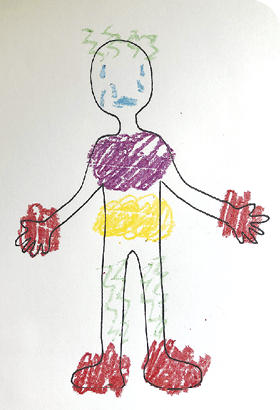
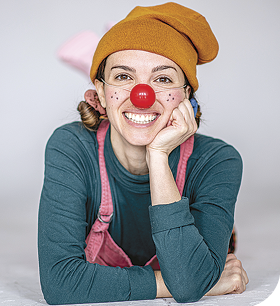
There’s this exercise that I like do when I work with kids. It helps us to explore how our feelings are something that we experience in our bodies as well as our minds. First, I give the child a piece of paper with the outline of a person. I ask them to colour the location on the body where they feel certain emotions and match it with a colour. For example, they may feel red/anger in their hands: “I’m so mad I could punch someone!” Or feel yellow/nervousness in their bellies: “I have butterflies in my tummy!”
Sometimes, a child may fill the outline of the person with one colour, but this may not match what behaviour is happening on the outside. For example, the child could be acting out with angry temper tantrums or be completely withdrawn, however their outline is covered in just one emotion: fear.
Anger and disengagement can mask more vulnerable and raw emotions like sadness or fear.
When I personally take the time to shave down the layers of an emotional outburst, it usually comes down to “I’m scared.” This may not be the reality in every case; however, it can give us insight into what may be happening under the surface.
This is an unfamiliar and uncertain time. Children are extremely empathic and can pick up on the stress that this virus is having on our daily lives. It’s often scarier when things aren’t being said as they can tell that the energy has shifted, but they don’t know why. With the recent news of schools in Ontario not returning this year, despite initial excitement, this can be scary and a big loss for kids. Loss of routine can mean a loss of control.
We may all be feeling a lot of big complicated emotions right now and not know how to express them. What we are feeling on the inside may not be what we are expressing on the outside.
How can we help our children increase their emotional vocabulary and express feelings in a positive way? How can we do the same as adults? Here are a few ideas that may work with kids and kids at heart:
Name It to Tame It
The idea “name it to tame it” is a strategy to help make sense of our experience and feel more in control. When big emotions are out of control (right-brain), telling the story of what’s upsetting us (logical left-brain) integrates the brain, names the fears and helps to tame them.
Rose, Bud, Thorn
Many of our routines have disappeared. Having a simple daily check-in with each other is a great way to put words to emotions. A popular check-in tool is “Rose, Bud, Thorn.” This is good to do at dinnertime or at the end of the day.
Rose: share your favourite part of the day
Bud: share something you are looking forward to doing tomorrow
Thorn: share your least favourite part of the day
Play!
Some of the best conversations take place while doing something else. Play is a child’s language, and sometimes in order to talk about big feelings it’s easier to play while doing it. We can gain insight into their inner worlds or it may just be a great way to distract ourselves. Doing activities your kids like to do makes them feel connected and more secure. This goes for adults too.
Providing space for kids to express themselves and acknowledge that it’s okay to feel a lot of feelings right now is a wonderful way to support them in this bizarre time.
Some resources you might check out are <anxietycanada.com>, <aboutkidshealth.ca/covid19>, and <childmindinstitute.org>.
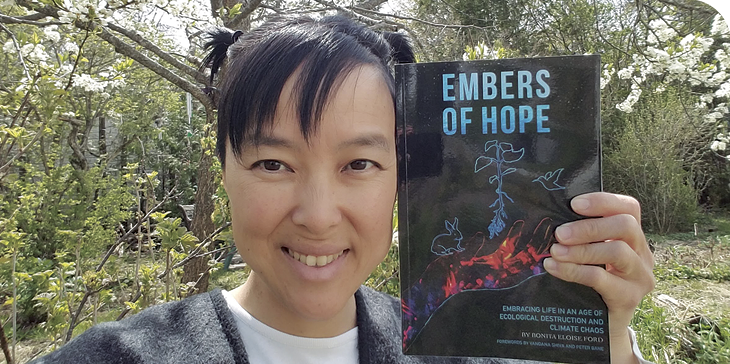
Bonita Ford is a co-founder of Permaculture Eastern Ontario and author of the new book Embers of Hope: Embracing Life in an Age of Ecological Destruction and Climate Chaos. We contacted her to find out how this book came to be, and how she hopes it can help us all to “nurture the small forces that may radically transform our world”.
theHumm: You had me from the title, because hope seems to be one of the most precious “commodities” — albeit one that isn’t for sale in the capitalist world. Why do you think it is important for people to remain hopeful even (or perhaps especially) in the face of unprecedented challenges?
I allow myself to feel both hope and despair, because they are healthy feelings and they help me get in touch with what is really important to me. Grief can open our hearts and remind us how deeply we care. However, if we dwell only in grief, we may be inclined to give up. If we all gave up and stopped trying to make the world a healthier and kinder place, we would be complicit in our collective undoing.
On the other hand, hope can fuel us. I need it in order to continue imagining and creating; it enables me to work towards what is possible. For me, hope isn’t simply a passive emotion or a state of mind. It’s accompanied by action.
When I first read about the healthcare system in Italy in near collapse due to the COVID-19 crisis, I feared for our communities here and I wondered how our local hospitals would cope. Shortly thereafter, I read about — and then started looking for — stories of everyday people sewing and donating masks to hospitals and offering free meals to frontline workers.
I am not hopeful about institutions ensuring our wellbeing in the long-term. Rather, I am hopeful about our communities. Last month, when my partner and I were a bit sick and in isolation, our neighbours brought us cookies and maple syrup, a friend went grocery shopping for us, and several people messaged to ask us if we needed anything.
Hope is about cultivating relationships with the people around us now, so that when we need it, these relationships will be strong enough to support us later.
Over the past 18 years you have given courses around the world on permaculture, reiki, and compassionate communication. How have these pursuits informed the writing of this book?
All of these holistic practices have shaped the way I relate to the world, and as such, they contribute to my perspective and my writing. They have taught me that I am part of Something Greater than myself and that I am connected to everything, so my choices and actions impact the life around me.
Teaching and facilitation have shown me that we are all teachers and that we are all students. I understand that I will probably be learning and growing for the rest of my life.
When I was writing Embers of Hope I wanted people to be able to relate — to what I’ve learned and also to what I’ve struggled with — and hopefully (re)discover that they too can enrich life through their everyday choices.
I can only imagine how much time and effort goes into producing a book like this one. Most authors aren’t in it for the big bucks, so this is both a creative and a generous act. What compelled you to write and publish Embers of Hope, and what do you hope people will garner from reading it?
I felt called to write it. It’s been over 6½ years since I started working on Embers, and although I struggled at many points in the process, I am so grateful that I stuck with it.
The writing gave me a sense of purpose. As I read about climate breakdown, I would feel the intense feelings, consider what I could do, and then write about it. I hoped that my challenges and reflections would encourage others too.
I think that death and the possibilities of ecological collapse and human extinction are incredibly daunting to many people. My relationship with death has evolved a lot throughout my life, and the death of two loved ones gave me a different way to look at our climate crisis. We don’t have to choose one or the other: resign ourselves to painful realities and give up, OR believe that we can change the outcome and keep trying. I discovered that I can grieve while also working towards what I hope to be possible.
In writing the book, I wanted to help people relate to death as something natural and approachable. I wanted to give people some tools to face ecological destruction and climate chaos and to feel their despair, fear and anger in a supportive way. Confronting what we have to lose can put us in touch with what matters deeply to us. Ultimately, I hope that Embers can inspire people to live more meaningful lives while taking better care of the life around them.
The subtitle of the book is Embracing Life in an Age of Ecological Destruction and Climate Chaos. Do you feel that the current COVID situation is eclipsing the climate crisis, or is it helping people to realize that our existence is more tenuous and interconnected than many of us were willing to admit?
Yes and yes. We are seeing governments put vast sums of money towards the COVID pandemic and make changes in a few days that seemed impossible just a few months ago. We have yet to see these kinds of resources or this fast of a response towards the climate crisis, despite an increasing number of governments declaring “climate emergencies” last year.
I think many people are beginning to see how interconnected we are and how easily disruptable our healthcare, transportation, and economic systems can be. At the same time, cities and nations in lockdown have given the rest of the living world a bit of a break from our industrial civilisation. During the crisis in China, one-third less coal was used at power plants and the nitrogen dioxide in the air was significantly lower.
What if we could clean up air pollution — and even slow climate breakdown — just by having most people in industrialised nations stay home for an extended period of time? To say that sounds naïve and even impossible. Yet, in 2019, how many of us thought it possible to have nations and economies come to a halt for months due to a virus?
I’m not trying to oversimplify the world’s problems. However, I am suggesting that sometimes we believe that certain solutions are impossible because we are collectively stuck in a certain mindset — and not because those choices and actions are actually impossible.
What are you personally most concerned about at this time?
I think the COVID pandemic and the response have been truly unprecedented. I think all of this has been a serious wake-up call. Perhaps it is waking different people up to different things, and I hope it is making many of us question the status quo and the way we live in our civilisation.
I am concerned that once the lockdowns are over, people will go back to their “normal lives” and forget about all of this: forget what terrified them, forget about how resilient they were, and forget about what good they might have found, including being less busy, having the time to cook at home, checking on friends, or appreciating being in nature.
I don’t want us to go back to being consumers and workers, rather than being thoughtful neighbours and concerned citizens.
What are you optimistic about in terms of what happens to our Ottawa Valley community during and after the pandemic?
I’m optimistic about the people. Even though I’ve heard stories about people yelling at grocery cashiers, I have continued to look for and find stories about care and generosity and kindness. I appreciate my neighbours and I know several frontline workers who are working hard and are still in good spirits.
I am hopeful — not because there isn’t selfishness or corruption in the world — but because I choose to look for what is good. And this allows me to continue doing my part.
To read an excerpt or pre-order a book with free gifts, please visit <embersofhopebook.com>.
We’ve been behaving ourselves and “staying the blazes home” for the past twenty-eleven weeks. It’s been fine up to this morning, when I scared myself half to death looking in a mirror. Who kidnapped my body while I slept? Lordy, I looked a wreck! Bedhead is one thing, but this COVID look that’s overtaken me is simply appalling! My hair makes me look like a Fraggle Rock stand-in.
The first weeks were all right as a good haircut will simply grow out, a little longer, but still retaining its shape. Then I tried tucking it behind my ear for an insouciant look. Not successful, I might add. The weather cooperated and for a few days my coiffure passed as windswept, but it’s gone beyond that now. It’s officially into frazzled mode. I did myself the disservice of cutting the stray pieces that draped over my glasses — not a good plan for someone who can’t wield scissors while looking in a mirror. Now I’ve got chopped off bangs that will be the laugh of the day for my poor hairdresser, when I see her again.
I met two friends last week and we all had this same manic expression, hair a mess, hands red from excessive washing, a little twitchy from lack of company. None of us mentioned our lack of grooming, and I noticed one woman had resorted to a too-short ponytail look anchored with multiple hairpins. I’m not sure, but I think another had used her dog grooming clippers to cut her hair very short. Desperate times, desperate measures! The three of us had accentuated our “do’s” with the most gawd-awful attire we could dig out: old jeans, grey sweatshirts, fusty old winter jackets still. We were all a picture of femininity and grace. NOT!
In general, men don’t seem to be as bothered about this as we women are. “Vanity, vanity, thy name sure isn’t man!” While we’re trying to tame some sort of decent style, men plop on a hat and call it good. Alan is starting to look like the old professor, with tufts over his ears and longer sideburns, but he’s not emoting over his appearance. Of course, he’d been to the barber just before the axe fell on normalcy. I, on the other hand, was due for a cut the following week.
In one of my flurries of organization, I switched over to the spring/summer wardrobe, all colourful and short-sleeved. April and early May were not kind, and I’ve had to haul out the sweaters, mitts, and jackets again. It really doesn’t matter since I never meet anyone but my neighbour (who is on the same fashion trajectory as I am) while walking dogs. Who takes time to chat in the grocery store? Who looks at anyone, or notices the ratty old jacket, or comments on the rubber boots on a rainy day? Simply “git ’er done” and get out of there. We’re wearing fear like a blanket, eschewing our usual spring/summer exuberance in deference to our fellow shoppers, and let’s face it, in the vague hope that no one recognizes this harried appearance as my new look of choice.
Enough is enough! Please, return the woman who used to be in my mirror, as this old biddy isn’t cutting it for me anymore. She’s a wreck! She needs her hair cut, she needs her summer wardrobe, and she needs a warm June afternoon to luxuriate with friends. Further, she needs some place to go other than the woods in the old work boots.
SOS! HELP NEEDED NOW!
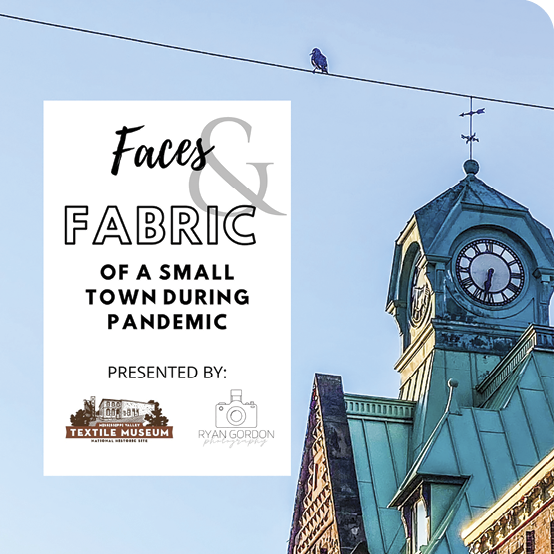
As the community grapples with a pandemic that is radically reshaping every aspect of public and private life, we are striving to capture the historic shift through the eyes of everyday people in Mississippi Mills.
The Mississippi Valley Textile Museum and Ryan Gordon Photography are partnering to create “Faces & Fabric of a Small Town During Pandemic”. They are intending to take “window/porch/social distancing photographs” of people in our community, including families, seniors, and front-line workers who have been dealing first-hand with the realities of COVID-19 while also telling their stories of hardship and loss, perseverance and community during these troubling times. These photographs will be treasured in the museum’s archives for future generations.
If you or someone you know would like to be captured in this historical time, please contact Michael Rikley-Lancaster at <curator@mvtm.ca> or Ryan Gordon at <rdg3542@gmail.com>.
Once the photographs have been taken they will be uploaded to Facebook (Ryan Gordon Photography) and Instagram <ryan_gordon_photography>. Images can be purchased there, and all proceeds will go to front line support in the community.
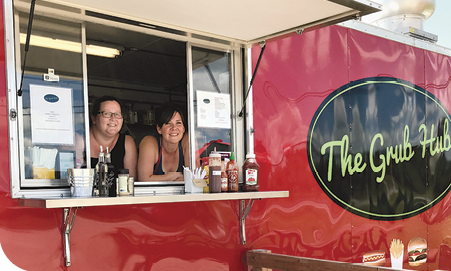
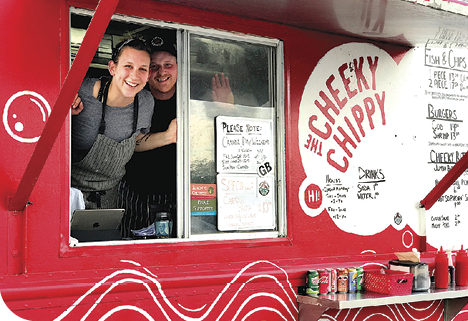
Months ago Weetabix asked his loyal readers “what starts with ‘F’ and ends with ‘uck’?”, and the correct answer had no apparent connection to the spread of a virus or a fundamental change in the circumstances and practices of our dining habits. Yes — the food truck is back in the limelight — and we are beginning a journey through the renewal of the very idea of restaurants in a time of social distancing. Some of you will, I am sure, think Weetabix overstates things when he says that cultural changes initiated in response to the pandemic will be long-lasting, but there are many reasons to expect that will be the case.
Begin with the origin of restaurants and even the term itself. The desire for prepared food and a place to consume it arose from urbanization, specialization of labour and travel. Gradually shops and stands that offered nourishment (restaurer is the French verb “to restore”) evolved to include seating so that patrons could relax and consume the offered fare on the premises. Speciation into niches of an ecosystem is a consequence of evolutionary processes. It is generally not a reversible process. Over the last few centuries our society developed numerous niches which in turn supported many variants on the basic theme of preparing and serving food to clients whose desires ranged from basic sustenance to the over-refined. Len Deighton (author, gourmet and food writer) once said “A wine snob can make the Japanese Tea Ceremony look like beer from a can.”
Weetabix attempts to match his comments to the value proposition of the establishment and is aware of some of the difficulties of the business in its different forms. That, dear reader, is why we expect that the whole industry will undergo substantial changes. Evolutionary processes are driven by reproductive success; business evolution is driven by economic success. And the requirements of social distancing have changed the economics of seating and serving areas, our work spaces and our travel habits. Take-out or take-away has moved to the mainstream, and changes needed to succeed in this part of the ecosystem are profound and pervasive. As with many changes, the pathway will be neither smooth nor consistent as to its short-term direction — there will be rebound and forced changes in traditional practice — some successful and some not. In the grand scheme of things, food is a central element of our social behaviours and there are fundamental forces that drive us to share food and its consumption in social settings. Weetabix believes that restaurants, chefs and food itself are entering a period of forced evolution that will produce a range of new and successful forms and practices. Some, like the peacock’s tail, are impossible to predict. Others, like the food truck, are here already!
Looking at the food truck as an organism, it appears to be already well adapted to the requirements of social distancing — no indoor seating being the first and most obvious point. No seating also means no serving staff to circulate, and most food trucks are configured for single-use cutlery and one-way containers. Properly set up, airflow can protect both the staff and customers, and since there is a lot of heat in the kitchen there is an inducement to have airflow in any case. Small staff in close quarters makes vigilance important to and for the proprietors, but self-preservation is motivating, and the scale of these establishments makes it relatively easy to pause operations if necessary. Where available, outdoor seating can be compatible with social distancing, but Weetabix advises caution in any case.
There are two other features of food trucks that may contribute to their adaptability: one is that they are relatively mobile and thus have some flexibility in location, and the other is that they are (at least compared to more traditional eat-in establishments) less capital-intensive — a feature somewhat offset by their lower production capacity per person-hour and higher consumable costs. Finally, elegance and diversity of presentation take a back seat to ease and speed of assembly. Look for creative solutions in this area as the genre evolves. The subspecies of food truck known and loved as the “chip wagon” is, in evolutionary terms, stable. It is specialized to its niche and unlikely to respond with significant phenotypic changes. Nor are its clients, and while this is not a bad thing, Weetabix has done one “tour des frites” already and has but one stomach to give for his art.
An interesting thing about food trucks is that their evolutionary origin was not a response to the present situation. Many of them are the vehicles for entrepreneurial drive of their proprietors, but some are the result of capital constraints and the ambition for culinary self-expression. Weetabix predicts the rise of the “gourmet food truck”, the “ethnic food truck” and, of course, more BBQ. All of these can already be found in some locations, and given the motivated talent and demand for quality and variety, there should be a proliferation of new establishments to take up already established demand.
People like to eat out — sometimes a euphemism for not having to prepare their own food, but often a reflection of the available diversity and quality of available offering. Chefs like to prepare and serve food. These are fundamental motivators that will continue to support restaurants even as they are forced to change their physical form. In previous articles, Weetabix has written about establishments like The Greene Mill <facebook.com/thegreenemill>, Cheeky Chippy <facebook.com/cheekychippyft>, The Jolly Hog <facebook.com/thejollyhog> and The Grub Hub <facebook.com/TheGrubHub613>, but there are others and there will be more. Interesting and creative solutions to packaging and presentation are in the works and there are rumours that some operations are considering how to cope with the challenges of four-season operations. Meanwhile, it is summer, and we should enjoy the opportunities presented by food trucks and their operators. Eat safely and eat well!
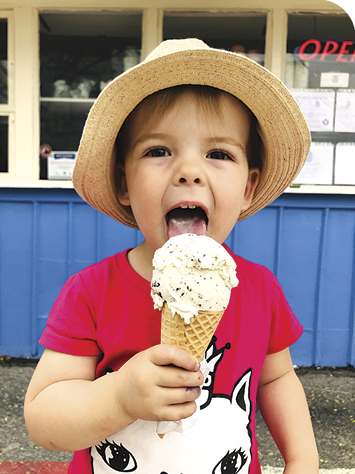
Hello again friends! I hope you and your littles are ready for a 3-month summer “vacation”. But one from the ’50s without camps, daycares or programmed sports… and for many, juggling working from home. Sounds idyllic, right? Okay, this doesn’t exactly sound like vacation, but if there’s any advice that I can offer it’s that the summer of quarantine begins now!
Yes, you may be wondering if I’m the minister of education to declare something like that, and to be clear… no I am not. But as the daughter and daughter-in-law of teachers, I think it’s safe to say that teachers everywhere (I’ve polled about five of them) are saying “look, we can get your kids back up to speed in September as long as you don’t traumatize them right now. Just read them a book or two.” On that note, we highly recommend you pop over to the local library for a curbside pickup of Mo Willems’ Elephant & Piggy book Should I Share my Ice Cream?
Anyways, given my patience level right now, I’m taking that teacher advice as an official declaration that school is out early! I plan to roll up a piece of printer paper and let our SK-er walk across our back porch to loud hoots and claps from her Granny & Nana (6-feet apart of course) and Alice Cooper playing loud on my speaker: “well we’ve got no choice, all the girls and boys… school’s out for summer!” — the old DIY Kinder Graduation!
So now that we can dump that pressure cooker of trying to login to online activities, we can look forward to 14 weeks of family summer camp! As I write this, beaches, splash pads and swings across the province are still closed. So unless you have your own cottage (if so, then “go jump in the lake”! But literally, you don’t need to read any further. Your summer is planned! “Go on, git”…) For the rest of us, I’ve racked my brain to figure out how to keep us and our littles cool in the Valley, and this is all I could come up with. I call it the “Passport to Brain Freeze”.
Thank the heavens that ice cream is an essential service! And since we all need to do our part to support local and put our CERB dollars back into the Canadian economy, we can visit ALL the ice cream shops in the Valley!
Want to Play?
1. Cut out the PASSPORT TO BRAIN FREEZE
2. Take a brain freeze selfie or video at any of these locations
3. Post your photo to Facebook or Instagram using #brainfreezepassport and tag theHumm to be entered to win an amazing Brain Freeze Gift Basket!
If anyone manages to get their passport stamped by all ten participating vendors, you will get an extra ten entries! Now go — freeze those little brains. And congratulations to all the graduates out there, big and small. Stay safe and try to enjoy this #summerofquarantine.
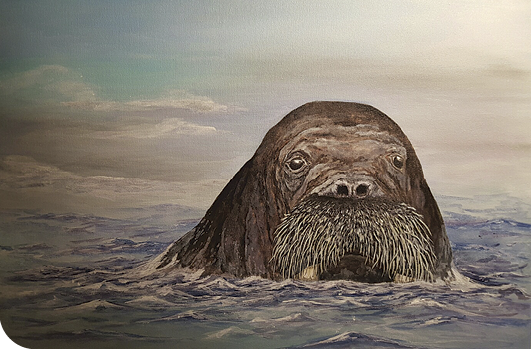
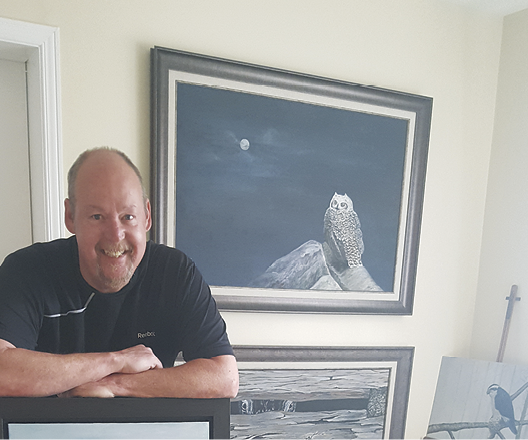
Art… and Soul
A new artist is blossoming in our midst. Rising to the COVID-19 challenge, Burnstown artist and businessman Jeff Wallace is discarding his anonymity and charging into the fray, determined to make a positive contribution. But first, introducing:
Jeff Wallace — Artist
Wallace has only recently arrived in a place in his life where his first love, art, is able to play a bigger role. As Forrest Gump’s mama always said, “Life is like a box of chocolates. You never know what you’re gonna get.” Jeff always loved to draw and earned a diploma in graphic design at Cambrian College of applied arts and technology in Sudbury, anticipating a career in the field. However, the industrial scales company he had been working for during summer breaks offered him a job in Ottawa when he graduated, and he spent the next ten years working in the service area and learning the business. In 2005 he started his current business, GTR Scales Ltd., and ran it from an office in Arnprior. Today he enjoys living on the Madawaska River between Burnstown and Springtown, where he juggles business responsibilities with his growing commitment to his renewed interest in painting.
Forrest’s mama was right. About seven years ago when Jeff’s marriage ended, he realized he had both the time and the urge to start painting again. He still had art supplies from his student days, and he had “kept his hand in” by painting gifts for friends over the years. As he puts it, he enjoyed “a flurry of art.” He participated in an art show in Calabogie and accepted a commission for a pet portrait. Animals are his chosen subject. A longtime hunter and fisherman, he has an affinity for the outdoors and its four-legged inhabitants. Pet portraits proved too constraining for him. He prefers selecting the wild subjects that appeal to him when he feels the urge to create, and the artistic liberty to portray them realistically in settings he chooses.
We spoke briefly about the tension between hunting and painting, and as a law-abiding hunter Jeff doesn’t see a conflict between shooting a turkey and painting a striking portrait of a turkey. He pointed out that it was turkey season right now, and that only the males were fair prey to allow the females to reproduce. His sense of humour caught me off-guard when he explained that a hen could easily find another husband because hers was a turkey. I forgot to retaliate by telling him that his delightful portrait of a racoon peering in a screen door was particularly appropriate right now. Racoons have been declared the de facto mascot of 2020: they wear a mask, wash their hands constantly, and “racoon” is an anagram for “Corona”. (Checking further, I discovered that “Corona Virus” is an anagram for “Carnivorous”!) And now, introducing:
Jeff Wallace — Charitable Entrepreneur with “Art Helping Canada”
We wrote about Jeff’s brainchild, Art Helping Canada, in our May 21 edition of Hummail (see below to sign up!) but many of our readers aren’t yet aware of our publication’s online presence as we negotiate pandemic-induced business constraints. Wallace’s brilliant win-win initiative deserves widespread notice and participation. In an impulsive gesture to contribute during a challenging time, Wallace talked to his local Metro store manager in Arnprior about donating one of his paintings to raise funds for those in need. The manager suggested doing a raffle, with the funds going to the local food bank. After Jeff donated another painting to the Metro in Renfrew, he “started thinking on a much larger scale — why not create a website and solicit other artists to participate in online charitable auctions?” Art Helping Canada was conceived!
Jeff describes what happened next as almost as rewarding as the job he had as a kid delivering flowers. Everybody has been happy to see him and excited about what he is bringing to them. Basically, Valley folk enjoy being good people and helping each other out. He discussed his idea with Patrick John Mills, the poet and abstract painter who just opened the new Art Factory in Renfrew <liveloveartfactory.com>, and Patrick suggested that Jeff offer participating artists an optional commission of up to 40% of the auction value of their art. Artists are particularly impacted by event closures and many of them are struggling as well. Jeff invites each contributing artist to select the food bank of their choice so that regardless of where they live, they are giving back to their community. The first charitable online auction of original art at <arthelpingcanada.ca> went live May 20!
Maybe it was his experience as a flower delivery boy, or maybe artists are incredibly generous people, or maybe he’s just irresistible; Wallace hopped into his truck and returned from Wilno with wonderful paintings by two of the three artists celebrated in the beautiful art book Wild Women Painters of the Wilderness. He has already secured more than forty striking original artworks from generous Canadian artists, and the auctions are underway on a weekly basis.
The website at <arthelpingcanada.ca> is fully functional, and Jeff’s goal is to auction off three to four pieces per week. The artworks that will be offered in upcoming auctions are well displayed and documented at <arthelpingcanada.ca/upcoming-art>. What a win-win opportunity to acquire a wonderful original piece of art — and support a food bank at the same time! If you are interested in donating a work of art, just check out the “Call to Artists” tab on the website. We encourage you to visit the site often, and please tell your friends!
And to sign up for our weekly Hummail e-newsletter, just visit <thehumm.com> and click on the “subscribe” box!

Until July 10, Almonte’s Sivarulrasa Gallery is pleased to partner with the Carleton Place and Beckwith Heritage Museum to present KITCHEN, an exhibition that elegantly combines works by four contemporary Canadian painters with artifacts of kitchens past from the Museum’s collection. This exhibition has been more than a year in the making, and the organizers are grateful to the artists for completing their paintings despite many challenges posed by the current pandemic. The exhibition can be viewed virtually or at the gallery (with physical distancing) — hours of operation are Wednesday through Sunday from 11am to 5pm.
The kitchen is often called “the heart of the home”. The act of cooking, and of sharing a meal, has always been a powerful symbol of our culture, our history, and our identity. What we do in the kitchen connects us to our past, to our bloodlines. Covid-19 and stay-at-home orders have forced upon us a togetherness in our homes. The pandemic has led us back to the kitchen, the traditional gathering spot. The constant of the kitchen, and the joys and comforts we experience there, are helping us adapt to isolation. These joys and comforts will be there still when the pandemic recedes and we open our homes once again to welcome friends and family.
Artist Karen Haines sees the kitchen as a place of safety, where families gather, share stories and make memories for a lifetime. Her still life paintings pulsate with the energy of the everyday. Caroline Ji explores the intermingling of the kitchen and the artist studio, a space that combines brushes, cups, studio props and sinks. Cathy Ross aims to convey the uniqueness and special character of everyday objects in her watercolour works, exploring the intimacy and subtle joy of the ordinary. Gillian Willans’ depictions of interiors, including kitchens and everyday spaces, is both nostalgic and critical, steeped in questions of gender and social structures. Devoid of figures, her paintings invite the viewer to imagine each private space as a stage on which a range of social interactions play out.
The artifacts from the collection of the Carleton Place and Beckwith Heritage Museum invite viewers to imagine and recollect the joys and tribulations of kitchens past. For example, a cast iron frying pan #3 produced at Findlay’s Limited in Carleton Place recalls the company’s range of frypans, numbered from 1 to 10. In operation for over 100 years, this family-owned foundry produced iron cookware, furnaces and woodstoves, including the best-selling Findlay Oval Cookstove.
Please visit <sivarulrasa.com/exhibitions/kitchen> for more photos, and <virtualgallery.sivarulrasa.com> for video clips. Sivarulrasa Gallery is located at 34 Mill Street in Almonte.
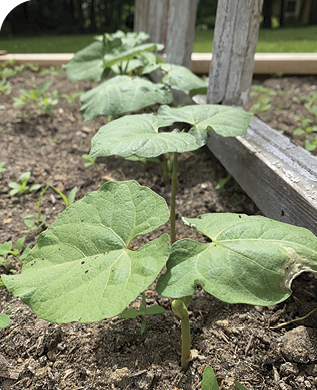
Missed planting the vegetable garden on the May 2-4 weekend (well it was a bit early this year)? Do not despair if you haven’t planted your entire vegetable garden yet. It is not at all too late to start a vegetable garden. Seeds of short-season vegetables such as beans and zucchini can be planted throughout June with a reasonable expectation of success. Vegetable seedlings such as tomatoes, peppers and cucumbers may still be planted (with some hope of success — look for short-season varieties — you might want to carry a good seed catalogue to the store with you). In all likelihood seasonal garden centres at box stores will have these plants on deep discount as soon as they wrap up their operations for the season.
If you choose to celebrate Canada Day by planting your vegetable garden, you will still have about two-and-a-half months (about 75 days) of reasonable growing conditions for plants that need heat. Plants such as beans may reach maturity in as few as 50 days from seed, beets a few days longer and zucchini a similar period. If they are planted in warm moist soil they should germinate and grow very quickly to maturity, leaving a period of about three weeks to enjoy a harvest. However, it is important to realize that plants that love heat such as beans will definitely slow down into September as the days get shorter and the temperatures get cooler. Carrots may also be started now for a last crop for winter storage. Frequent watering or covering the row with a board or bag may be necessary to encourage them to germinate if the weather turns hot.
Even if your garden is fully planted, there will be opportunities for additional crops. While it seems like we are still a long way away from a meal of fresh beans from the garden, nonetheless it is time to think about planting another bed with beans and beets and maybe carrots (perhaps where the lettuce and spinach have gone to seed and been pulled out). This is often termed “succession planting”. Rather than plant all of the beans at once, plant every two or three weeks, thus spreading out the harvest over an extended period. I will want to plant my last crop of beans about mid-July.
Some gardeners are also choosing to plant their potatoes late in an attempt to escape the ravages of the Colorado potato beetle. The adult beetle over-winters in the soil, emerges early in the spring and then lays eggs on newly growing potato plants. If you plant potatoes late, the beetles have hopefully moved on to your neighbours. You will probably want to plant a potato that matures in 60 days rather than a 90-day potato.
For plants that are frost tolerant and that prefer cooler growing conditions such as lettuce, radish, arugula and spinach, the growing season may well extent to the end of October — a whole four months of growing time left. Mid-August is probably the best opportunity to plant — they will grow very well as the days get shorter and cooler in the fall. The trick is to get them to germinate in warm soil. Frequent watering may be necessary. A trick that I have read about but not yet tried is to put pea seeds in a moist paper towel, put that in a baggie and then put it in the refrigerator. Check frequently, and when the seeds have germinated plant them in the garden and then stand back!
If you grow garlic, you may want to start thinking about removing the scapes round about the end of June. The flower/seed heads that grow on a long stem from the middle of the garlic plant are called “scapes”. They can be snapped off and then minced and used in cooking or made into pesto, as they have a strong garlic flavour. Connoisseurs recommend that they be used as soon after picking as possible as they become tough quite quickly.
There is virtually unanimous agreement that if the scapes are removed the garlic plant will put more energy into the bulb, which after all is the part of the plant that we want to harvest. Some gardeners pick the scape when it has one curl, others wait until it has two; I pick it whenever I get around to it!
The question of removing suckers from tomatoes does not enjoy the same unanimous support — in fact, it may instigate a spirited debate! And in general, there is a lot of discussion about the best way to grow tomatoes. Many people believe that suckers (the branches that develop where the leaves join the main stem) should be removed so the plant puts more energy into the fruit on the main stem and that lower leaves should be removed to help prevent blight. Generally, I do not sucker or prune my tomatoes. I tend to believe that it is a waste of time and may even contribute to sunscald as it reduces the foliage canopy. I believe that the key to healthy plants is to set down mulch under the plants and then have a cage to support each tomato. The mulch helps provide consistent moisture and the cage keeps the fruit off the ground. That being said, tomatoes are generally very vigorous and adaptable plants, and whatever has worked for you is the best way of doing it. Happy gardening!
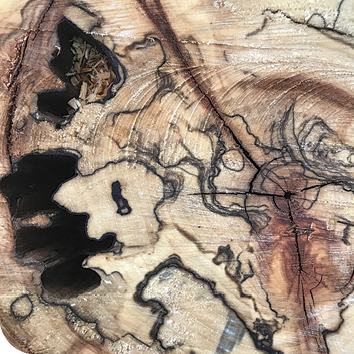
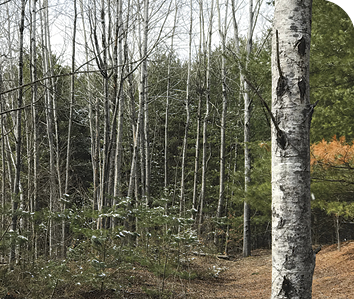
A Poplar round supports my weight. Its dying body lies here, sprawling in pieces around me. Rings of honey-coloured carbon circle in around dark, decaying heartwood that Woodpeckers have already begun to investigate in search of larvae. We sit here together, Poplar and I, on the tenuous, thin layer of unfolding life that is happening between our bodies and the eons of sand lying beneath us.
An accumulation of debris has fallen over decades — an offering to the Earth from the sanctuary of other Poplars around us. Leaf litter, twigs, branches and other detritus have ever-so-gradually collapsed into a matrix of humus, creating a home for the intertwining lives and deaths of microscopic beings that inhabit this little patch of place.
35 years ago you, Poplar, saw potential in what was an empty and exhausted bit of sand between plantation and slope, where after a century-and-a-half of human affronts — logging, extraction and over-grazing, the holy trinity of traumatic tactics inherited from the old country — nothing further remained for us to take. Seizing your moment, you settled in, quietly yet tenaciously holding ground through the conditions that icy winters and droughty summers posed, and slowly surrounded yourself with community.
35 years later, what I sense while sitting here with you still speaks of disruption, in spite of the sheltering presence the grove of you has created. There is a weariness and clutter to the surrounding space that feels incoherent. The debris left by those branches felled by ice, plagues of caterpillars, wind, or my human efforts to “tidy up” your diseased kin on this knoll is unsettling me. It feels like something coming undone.
I’d rather not sense the struggle here that the land presents to me — the death, the disease, the damaged — the litany of small and large traumas that pile up like memories around my feet on this patch of sand and decay. My impulse is to sidle home to the cushions and comfort of the fireside — the regularity and security of those domestic walls — and never return. Or to seek a spot somewhere else on this land that feels less of a slight to my senses. Or, were it possible, to just find finer horizons to belong to; to fill the almost imperceptible but ever-present longing for something else — something without the shadows, the baggage, the discontent. Something instead less burdened and more beautiful, more vibrant, healing, exciting. I’ve seen it on Instagram. Surely such a place exists?
But in the midst of such flights-of-fancy, I can’t help but be irritated by the presence of a subtle yet niggling “moral-monkey-mind” which reminds me that such escapes simply measure up to something akin to abandonment.
How to resist the temptation to turn away, and instead turn more patiently and tenderly towards all that is here, in front of me (or is it within me?), right now, with a clear, steady and loving gaze? I grapple with the felt sense of suffering this place holds — an ache that echoes in my bones. Grief surfaces and perhaps even guilt, especially when, occasionally, trails of causal breadcrumbs lead back to my own door. What troubles, dear Poplar, need to be tended?
As a global pandemic washes over the planet, I think of the billions grappling with the challenges of isolation and staying put. Fear, hardship and very real trauma are being experienced in the face of illness, death and great uncertainty. The world seems to be experiencing an epic pause. I can hear the Earth sighing. It feels like a global reckoning may have landed on our collective doorstep.
After more than two months into self-isolation it seems as though many of us are getting a taste of what it’s like to stay in — and with — place. Travel plans, socializing, unnecessary movement anywhere has been prohibited. Our lives have stilled and become confined to more humbling boundaries than many of us are used to. There is no longer anywhere to run — except perhaps down virtual rabbit holes! Conversations about staying put, slowing down, simplifying our lives and just being, rather than doing more, are getting a lot of airtime for a change. We are now beginning to sense the resilience, discipline and endurance — as well as the spirit, heart and generosity — that will be required to see us through to the proverbial “New Normal”. Can we begin to imagine what that New Normal might look like?
They say that every challenge presents an opportunity. And while studying the leaf litter around my feet, I see the tiniest shoot of green poking out of the duff. I wonder if what is being offered in these surreal times is an opportunity to be “composted” ourselves! Perhaps old worn skins and structures that are past their prime need surrendering in order for a novel reconstitution to arise that better supports life for all. Perhaps too, in the shadowy unraveling of these times, we will find the space and the courage to listen closely to the murmurings of the Earth and to glean some wisdom from her that will inspire the journey to come.
The Poplar says “Stay put”. The Poplar says “Look into my heart. I am dissolving. But already I am nourishing the birds”.

Here’s an overview of PRIDE plans (as of press time) across the Ottawa Valley. We recommend following these groups on Facebook, because things may change and activities may be added as it becomes safe to do so. Then check out the next two pages for fascinating interviews with two members of the Ottawa Valley 2SLGBTQIA+community!
Carleton Place
Carleton Place PRIDE 2020 member Paolo Villa explains that the COVID situation has prompted organizers to shift to more virtual events, so they will be celebrating from September 4-12 and calling the celebration “Out Inside”. It will be filled with at-home challenges, live performances and speakers on FB live and YouTube, scavenger hunts and more. They are hoping that the PRIDE flag will fly from the Carleton Place Town Hall for that week, and that there will be an official PRIDE Day. The best way to stay up-to-date is to visit their event page on Faceook (Carleton Place Pride 2020 presents Out Inside).
Queer Connection Lanark
The Lanark County PRIDE banner will fly in Perth from June 1 to 6, and Queer Connection Lanark will be handing out rainbow stickers to businesses. Nothing has been finalized online yet, but stay tuned to <facebook.com/QueerConnectionLanark>!
Smiths Falls
The Town of Smiths Falls will be flying the PRIDE flag for the month of June at the Town Hall. Smiths Falls Pride Festival 2020 Chair James Ae Perkins writes: “After much consideration and hesitation, Smiths Falls Pride will be cancelling this years scheduled parade and events festival. Our annual goal has been to host a safe and family friendly event that is reflective of and encompasses the entire community. The cancellation is in line with many Pride parades and festival cancellations across the country. We greatly appreciate all the support that Smiths Falls residents and surrounding communities have given to the fantastic, colourful celebration of the LGBT+ community and the salute to diversity.” <facebook.com/SmithsFallsPride>.
Mississippi Mills
Back in February, a committee of local folks was putting the final touches on plans for an exciting week’s worth of events for the inaugural PRIDE in Mississippi Mills initiative… only to come to a complete halt in March/April due to the pandemic. But according to committee member Karen Luyendyk (who is also a Clinical Educator for Trans and Non-binary Health for Rainbow Health Ontario and a parent/ally), “a couple of weeks ago we performed CPR and quite successfully breathed life back into PRIDE in the context of a pandemic.”
The committee has done a remarkable job of pivoting from a week of in-person activities (plans had included a hike, a spoken word event and comedy night, a PRIDE bike ride in conjunction with Mississippi Mills Bicycle Month, and a drag show and disco, among others) to a full month of online events. Below is their line-up, so be sure to follow them on Facebook <facebook.com/prideinmm> or Instagram <@prideinmm>!
Meet us Mondays: Mississippi Mills business owner Peggy White will post weekly features on the many Mississippi Mills businesses owned or managed by members of the 2SLGBTQIA+ community, including: Sumac Loft Design Services, General Fine Craft, Fabulous Fries, Mississippi Valley Textile Museum, Curious & Kind, and Peggy White Guitars.
Challenge Tuesdays: Hey Mississippi Mills! Show your creativity and post your pics and videos:
Week 1: Create rainbow/trans coloured works of art in your homes and yards from articles found in your homes and yards.
Week 2: Wear as many colourful/rainbow clothing items as possible all at once (or create a one-colour-at-a-time fashion shoot) — individual and/or household/group pics or videos !
Week 3: Decorate your home/yard/windows in rainbow/trans colours
Week 4: Post your favourite photos and videos of the naturally occurring rainbows you’ve taken, and if you like, share the stories behind them!
Week 5: Stay tuned for this one!
Wonder Wednesdays: PRIDE in Mississippi Mills will post videos and articles weekly on Facebook and Instagram.
Thoughtful Thursdays: Chrissie Young (Positive Space Ambassador and Facilitator for the Federal Public Service) will post weekly covering the following topics: 2SLGBTQIA+ timeline in Canada, 2SLGBTQIA+ terminology: concepts and identities, gender inclusive language, and being an ally
Funday Fridays: Sara Fortin (Program Coordinator at the Youth Centre) will host fun craft making events for kids, including: rainbow rock painting, PRIDE wreath making, DIY rainbow grocery tote, and tie-dye.
The Mississippi Mills Library will also promote inclusive books and DVDs throughout June.
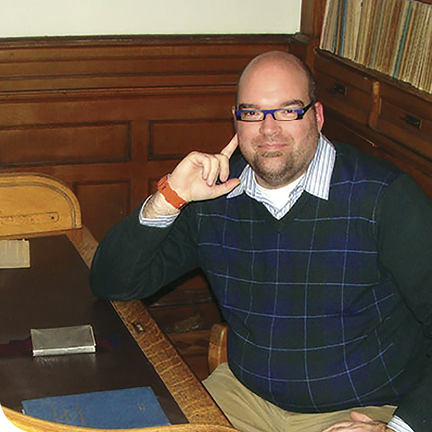
Michael Rikley-Lancaster is the Curator of the Mississippi Valley Textile Museum and a member of the group that was planning to launch the first-ever Mississippi Mills PRIDE Week this June. We contacted him to find out how both the Museum and MM Pride are faring.
theHumm: Since becoming Curator, you (with the assistance of your staff, board and numerous volunteers) have made many improvements to the Museum and have hosted incredible exhibitions by artists from around the world. Can you speak to the importance of supporting our rural cultural institutions during these challenging times, and assisting them in returning to “normal” once it is safe to do so?
Michael Rikley-Lancaster: More than ever the cultural sector (galleries, libraries, archives and museums) in rural communities need support. They are cornerstones that act to preserve, research, educate and enlighten rural communities.
Even though travel and tourism have changed, once the cultural sector can re-open we will be an escape for community members, because visiting a local cultural institution provides a place to learn, experience and enjoy undiscovered aspects of our community.
One of the museum sector’s growing initiatives is for museums to function as community hubs, encouraging residents to come together to share and enjoy their common experiences.
Community hubs are safe spaces for community members, they contribute to health and well-being, and their volunteers feel a sense of belonging. They contribute to greater literacy, knowledge and creativity. They also promote increased rates of volunteerism and a better sense of “knowing where you live.” While these cultural hubs are closed right now, they are working hard to create virtual hubs to keep their communities engaged. For a quick example: visit the Mississippi Valley Textile Museum at <mvtm.ca> and search the Almonte Gazette for local history or just a sense of “how it was back then.”
Museums and galleries boost the local economy, contribute to innovation, and are an integral part of the fabric of our community. Museums ultimately contribute to a better quality of life.
You recently began flying the rainbow flag at the front door of the Museum. Why is it important for cultural institutions — and other public places — to be visibly welcoming to members of the 2SLGBTQ+ community?
At the beginning of 2019, the Mississippi Valley Textile Museum hung the rainbow flag at the front of the museum. It was only recently that it was removed (it was damaged by the wind) and its replacement is pending.
The MVTM raised the rainbow flag to celebrate “Friendly Almonte, Mississippi Mills”. This flag represents a welcoming and inclusive attitude in a community that celebrates the diversity of all who visit us and who call this place home. Originally the flag included eight stripes, but colours have been removed due to fabric availability, creating the current and most recognized form. Each of the six colors has a meaning: red is life, orange is healing, yellow is sunshine, green is nature, blue is harmony and purple is spirit.
This flag of many colours also represents the unity of all and the celebration of differences.
Rural cultural institutions are gathering places for the whole community. We are places of inclusion. The rainbow flag shows that we are a welcoming and safe space.
How is the Pride in MM group pivoting their planned activities in light of the current situation?
The committee has changed from planning a week of in-person events to a month of online events and learning opportunities. You can find them at <facebook.com/prideinmm> or on Instagram <@prideinmm>.
You and your husband moved to Almonte “from away” several years ago. How do you feel our rural community is doing in terms of being welcoming to the 2SLGBTQ+ community?
First, a short explanation: 2SLGBTQ+ stands for: 2S=Two-spirit, L=Lesbian, G=Gay, B=Bisexual T=Transgender, Q=Queer & Questioning, += And so many more other identities too! The acronym 2SLGBTQ+ refers to gender and sexual identities and is the most commonly used, but as the plus indicates there are many other ways folks identify within the spectrum of gender and sexual identities.
My husband and I have always felt welcome in Mississippi Mills. The museum volunteers, old and young, welcomed both of us into their circles.
In 2005, before moving to Mississippi Mills my husband and I lived in Ottawa, where we were planning our wedding. We were having a difficult time finding someone in Ottawa to marry us. At the time I was working at the Canadian Museum Association in Ottawa with Emily Paige (raised in Pakenham). While talking with Emily about this challenge, she recommended we speak with Heather Kincaid at the United Church in Pakenham. We then set our wedding to be held at the Mill of Kintail Cloister with Heather officiating. She was so welcoming and was so pleased to marry us.
We held our wedding reception at the Iron Works (now the Barley Mow) in Almonte. To our surprise that was the weekend of the Highland Games in Almonte and some bagpipers at the end of the games were having a drink in the pub. They decided to surprise us by serenading the reception.
We really enjoy the friendliness of this community, in contrast to what we sometimes encountered in Ottawa in the past. Shopping for tuxedos together for our wedding was another comical experience in Ottawa; I do not think that the older gentlemen ever understood…
Have you noticed any improvements over your time here?
I am always excited when I see more stores and community organizations in Mississippi Mills with a rainbow sticker or a flag. Mill Street Books always flies a rainbow flag out in front of their store every June. The General Fine Craft keeps a pride sticker in their window, and these are only two examples. When I was young, I only ever saw a few rainbow flags around, even in the largest cities.
These times of social isolation are hard on everyone, but perhaps particularly so for marginalized groups. Are there services or assistance available for folks in this area?
There are several services listed online for support groups for 2SLGBTQ+ folks here in Lanark County. <champlainhealthline.ca> is a good start in looking for support.
For youth who may be questioning or who have immediate concerns there is a helpline at 1–800–268–9688 and more information at <youthline.ca>.
What are you personally most concerned about during this challenging time?
I am most concerned about everyone’s safety at this time, and I think that is our number one priority. At the same time, I think that mental wellness needs to be part of our concerns. As we have had to self-isolate, those who are alone or of a unique minority can feel even more abnormal and isolated… maybe a simple rainbow flag can make all the difference to reduce thoughts of self-harm, or just to improve everyone’s state of mind.
I also want to point out that if you are in crisis or need help these services are available: Lanark County Mental Health Crisis Service, available Monday–Thursday 8am–8pm and Friday 8am–4pm at 1–613–283–2170; and the Distress Centre of Lanark, Leeds and Grenville, available 5pm–midnight, seven days a week, toll-free at 1–800–465–4442
What are you optimistic about in terms of what happens to our community during and after the pandemic?
This time is making us connect and learn in different ways. Coming out of this we will appreciate even more what life has to offer. And I think cultural institutions in our local communities will be even more valued and visited.

Just as we were going to print, stories about the death of George Floyd started hitting the news and social media. theHumm doesn’t report on breaking news, but we thought this information about an Ottawa Valley icon and a basketball player he encountered at the University of Kansas in the 1930s might inspire.
From the play Naismith Is Colourblind (and He Can’t Drive) by Fern Martin:
In 1933 a black father dropped off his 18-year-old son, John McLendon, at the University of Kansas and told him to talk to James Naismith. John showed up at James’ office.
Naismith welcomed the youth into the program and invited him, as he did with all students, to swim at the University pool. And John could swim — he was the lifeguard at the black pool in Kansas City. But there was a problem. When John swam, the white students left the pool, and afterwards the University janitors would drain the pool. Naismith positioned two of his strongest athletes to stand by while John swam and after he completed his swim.
Then someone put up signs warning white students against swimming in the pool. Naismith removed the signs and took them to the president of the University, who supported his action.
Then he staged a dramatic demonstration. He took his students aside, pricked the finger of a white student and then John McLendon’s finger, and showed that they shared the same colour of blood and stated that each had the same feelings as part of their humanity. The only difference was a very slight thickness of the pigment of the skin.
From Wikipedia:
John B. McLendon Jr. (April 5, 1915 – October 8, 1999) was an American basketball coach who is recognized as the first African American basketball coach at a predominantly European-American university and the first African American head coach in any professional sport. He was a major contributor to the development of modern basketball and coached at both the college and professional levels during his career.
From ‘Forgotten’ no more: Coach and Naismith protégé John McLendon broke color barriers in basketball (published in Lawrence Journal-World):
The first person to be enshrined in the Naismith Memorial Basketball Hall of Fame as both coach and contributor, McLendon was first added as a contributor in 1979 and then as a coach in 2016.
“Their relationship was one of the amazing things in the film [Fast Break: The Legendary John McLendon]. Through McLendon you get to know this other side of James Naismith that I don’t think people talk enough about,” [director Kevin] Willmott said. Instead of strictly winning and losing, “he sees basketball as a way to better society and make better men.”
McLendon’s integration efforts continued through his career. “He not only labored tirelessly so that black college teams could participate in national tournaments, but also fought just as hard for equal access off the court,” [McLendon biographer Milton S.] Katz wrote in his hall of fame article. “McLendon refused to bring his Tennessee State team to the 1954 NAIA Tournament in Kansas City unless they would be allowed to stay in the same hotel and eat in the same restaurants as the white teams. He won that battle and essentially integrated downtown Kansas City.”
At its best, community theatre brings together people from all walks of life to share ideas and create friendships. This has been Rural Root Theatre’s strength since 2005, and they have no intention of stopping, current social distancing measures aside.
To accommodate ongoing government-imposed restrictions on gatherings, Rural Root has decided to take their next production entirely online. The upcoming production of Couples by Sean Grennan will stream live online from June 11–13 at 7pm. The play features a therapist and three couples who participate virtually in group couples’ therapy.
There is a lot of interest from other theatre groups and the author himself to see how this new format will be received. “It’s completely different from anything we’ve done before, and it’s not without its challenges,” says director Roy Ballantine. “We don’t know of other theatre groups who have tried this, so there will be a learning curve, and we’ll be at the mercy of technology. But we really wanted to do something that would engage our members, promote our sponsors and give back to our community.”
Each show will run approximately 30 minutes, with a brief intermission. Audience members will receive an email invitation that will allow them to register for the live performance. There will be no charge for the show, but patrons can make a donation to the West Carleton Food Access Centre.
For more information on the production, please visit <ruralroot.org> or <facebook.com/ruralroot>.
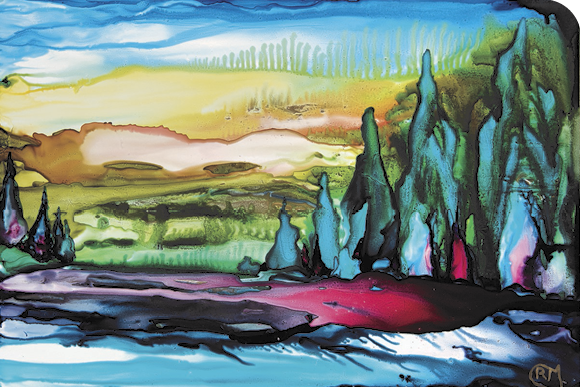

The good news for area art lovers is that many local galleries have been able to re-open — most with reduced hours and all with extra safety precautions in place. We highly recommend a visit to Almonte’s General Fine Craft <generalfinecraft.com> and Sivarulrasa Gallery <sivarulrasa.com>, Riverguild Fine Crafts in Perth <riverguild.com>, and Bittersweet Gallery in Burnstown <burnstown.ca/bittersweet>, among others!
However, all studio tours and collective art shows have been cancelled or postponed for the time being, so we wanted to let you know what the various Ottawa Valley art organizations are doing to promote their members online. It’s not the same as experiencing works in person, but online sales can help support local artists — and brighten your home — in the meantime. Here’s what they have to say:
Almonte & Area Artists’ Assoc.
Art in the Attic is an art show and sale where local artists of all ages and experiences celebrate their creativity. It is run by the Almonte and Area Artists Association and is our main event of the year. We invite you to join us for our celebration of our 30th annual show and sale — online at <almonteartintheattic.wordpress.com>. The show runs until June 7.
Art Works! Perth
Art Works! Perth is an organization of creative artists working in and around the town of Perth. The group was founded to provide a network for rural artists to come together to talk, learn, develop ideas and provide opportunities for artists and community members to become involved in the visual arts in the Perth area. The annual studio tour for Art Works! Perth provided an opportunity to meet some of the people who make art in our community.
However, because of COVID-19, the studio tour planned for June had to be cancelled for this year. But this has not stopped the artists from creating new works waiting to be seen.
The current members of Art Works! Perth Studio Tour have created a virtual tour of the 2020 artists with a selection of their work that is available for purchase. To see our virtual gallery, visit <artworksperth.ca> and view each individual artist’s page. If you are intrigued by a painting or art piece, please contact the artist directly for purchase details. All of their contact information is on the website.
In addition, follow along on the Facebook and Instagram pages for Art Works! Perth to see more new work by our talented artists. And of course, we hope to see you in 2021 at our studios!
Arts Carleton Place
Arts Carleton Place (ACP) offers two shows per year, the next of which is tentatively scheduled for the weekend of September 26, featuring 28 regional artists. The list of participating artists and links to their work and biographical notes can be found at <artscarletonplace.com>. This show is the re-scheduling of the Fine Art Show normally held in May. ACP strives to organize premier art shows where local artists of all kinds can sell their art at fair prices and local residents can purchase seriously good art directly from the creators.
Local Colours
Twelve artists forming the Perth-based Local Colours Fine Art Group (Nora Brown, Thérèse Boisclair, Judy Hollinger, Claire Jacobs, Barbara Jordan, Aileen Merriam, Peggy Orders, Pat Purdy, Cathy Rivoire, Linda Svarckopf, Dayle Van Alstine and Judith Versavel) are celebrating their 5th year together in 2020. Their annual fine art show (normally held during Perth’s Festival of the Maples) was cancelled this year due to COVID-19, but they have future plans. They invite you to check out <localcoloursartperth-on.ca>. Purchase inquiries are always welcome, and you can find contact information for each artist there. Many of their members have previously been profiled in theHumm!
Rideau Lakes Artists’ Association
The Rideau Lakes Artists Association’s annual Art show “Paint the Summer” has been cancelled this year due to COVID-19, so instead we will be hosting a virtual show/sale called “An Inspirational Escape”.
Since early May, our talented and diverse artists have been showcasing their art on Facebook <rideaulakeartists.com> and Instagram <instagram.com/rideaulakesartistsassoc>. Supporting your local artists has never been easier! Like, share, spread the word and contact the individual artists if you wish to purchase a painting.
The Ten Collective
The Ten Collective is a group of ten Canadian artists featuring diverse backgrounds and styles of painting. They were just gearing up for their third annual show at the Mississippi Valley Textile Museum when they had to cancel due to COVID, and they made the decision to put all of the artists’ new works on their wonderful website <thetencollective.com>. You can find the works and prices at that site, and then contact the artists directly to purchase or obtain more information.
West Carleton Arts Society
The West Carleton Arts Society (WCAS) is an active non-profit volunteer organization of vibrant, talented visual artists and fine artisans. The current environment has made it challenging to bring art to the community. You can connect directly with our artists by checking out their profiles on our website. WCAS has also intensified its social media presence to include artists’ new work and various social engagement activities. We are launching a new newsletter and if you are on our mailing list, you will receive regular bulletins about art activities and opportunities. Even if we must create alone, we can create together! Visit <westcarletonartssociety.ca> or find us on Facebook or Instagram.

Noé Charron is a 22-year-old non-binary trans woman (who uses both she/her and they/them pronouns) who started her transition while growing up in Almonte and working at Baker Bob’s. We contacted her to find out how her transitioning was perceived and received by the community, and what advice she has for people who want to try and foster a more welcoming and compassionate atmosphere.
theHumm: As an employee at Baker Bob’s, you were one of my only examples of someone who was transitioning in the community. I always felt that you provided great friendly service, and I always went away thinking that you were one of the bravest people I encountered. Does it annoy you when people assume you are brave? Or assume things about you in general?
Noé Charron : Haha, it’s actually a bit of a joke among the queer community! A bit of a tragic one, because we’re all told we’re brave for coming out, but for most of us, not coming out isn’t really an option that we have. For myself, I waited half a year before coming out to my family and only came out ’cause I reached the point where gender dysphoria had gotten so bad that each month I worried I wouldn’t make it to the next. That said, here I am, strong as ever! So maybe more resilient than brave? It’d be a great to reach a point where trans people didn’t need to be so resilient in order to survive being and becoming themselves.
As for people assuming things about me in general, it can be really frustrating! Everyone’s different, so obviously making quick assumptions about people seems silly, but it’s something we all do instinctively. It’s something big that I feel people should really try to catch themselves making assumptions, take a step back, and ask themselves where those assumptions come from and if they really want them to inform how they see any given person. I’m a 22-year-old polyamorous transgender punk, university drop-out, professional game developer and Twitch streamer, all things that are *loaded* with assumptions and stereotypes. Some of them are accurate to some degree, others couldn’t be further from the truth.
You only recently moved out of your hometown so this may be difficult for you to answer, but do you feel that there were factors that made transitioning in a small town easier than it would have been in a larger centre? More difficult?
It really depends! If I was in high school, I feel it would absolutely be easier in the city. As far as I’ve heard, there aren’t many resources for trans people in city schools, but definitely more than what was available for me in Almonte. My queer friends were harassed and bullied constantly in school, whereas my friends in larger centres were having a great time being visible and out. That said, being early in my transition in university, I’d still occasionally have random students call me slurs as I walked past them on campus, and people would often stare. When I moved back to Almonte and went back to work at Baker Bob’s, everyone was *extremely* sweet and respectful! I can’t say I’m sure if I would have had a similar experience had I been working at some place like Timmies instead. So it really depends on a lot of things, like how well cis people feel you pass as your gender, if you’re part of other marginalized groups, and the kind of people you’re interacting with!
Did you have strong allies while you were in Almonte? If so, can you speak to the importance of these people in your life?
I did!! While I was in school, Barb Lotan and later Ms. Packham, who both ran the school GSA [Gay-Straight Alliance] were wonderful and supportive, and even though I wasn’t out to them, they gave me space and resources that absolutely helped me feel more secure in coming to terms with being trans. After dropping out of university and coming back to Almonte to work at Baker Bob’s, both Bob himself and my coworker Nicola were especially great! They were always supportive, respectful, and considerate! I can’t even begin to describe how safe that made me feel amidst the anxiety of being very out and visible early in my transition. They were so good about getting my name and pronouns right, and would often fill in customers who were confused about my gender presentation, haha.
Do you feel that it is important for a community to have visible signs of inclusivity, such as rainbow flags on local businesses and events like PRIDE in Mississippi Mills? What other things could a small community do to be more welcoming?
Yes, it’s absolutely important! I know especially for queer youth, high school is an extra nightmarish experience, where hostility is expected and safety comes in the form of a handful of close-knit friends, so seeing support amongst the community at large is wonderful! I think some resources that would be great are better LGBTQ+ education in schools, pushing for doctors to be trained with trans healthcare (massively lacking in both small and large communities), and hosting queer public speakers, and boosting the voices of trans people!
These times of social isolation are hard on everyone, but perhaps particularly so for marginalized groups. Can you suggest some specific ways that people can be more sensitive to and respectful of you and other trans people in their day-to-day interactions?
Sure thing! Some quick things I know people are sometimes unsure of: If you’re referring to a trans person from before they came out, still use their current name and pronouns. Trans men are men, and trans women are women. If someone comes out to you as a man, then you’d refer to him as a trans man. Trans and transgender are adjectives, like tall, smart, and kind. If you’re unsure of a trans person’s pronouns, just ask! Really, it’s ok. A casual “Hey, what’re your pronouns?” is perfect and respectful. If you can’t ask, default to they/them pronouns. They/them pronouns have been used to refer to people of unspecified gender for literally hundreds of years, it’s nothing new! Trying your best not to assume people’s gender is also a good idea. As someone who knows many trans people, I’ve come to realize that it’s impossible to tell if someone is trans or not, and easiest to just think of people as genderless until they tell you otherwise. Not something I think comes easy to most cisgender people, but something absolutely doable with practice!
What are you personally most concerned about during this pandemic?
Honestly, a lot! I’m worried about the safety of people near and dear to me, I’m worried people will stop taking it seriously before it’s safe to, I’m worried about governments using the pandemic as a distraction to pass harmful bills, and worried for the mental and physical health of everyone when we come out of quarantine. It’s a scary time, and we’re going to be seeing the effects of it for a long time to come.
What are you optimistic about in terms of what happens during and after the pandemic?
The pandemic has highlighted a lot of systemic injustices that many marginalized people face daily, so my hope is that pushes for change can maybe resonate with people who found themselves previously not caring or being able to empathize. I would *love* to see people emerge from this with a stronger drive to make positive social change and political reform!
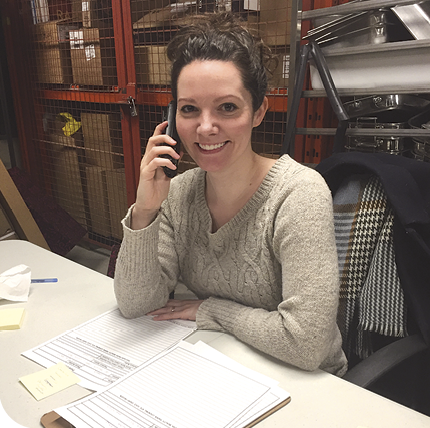
In small communities like ours, you just need to ask for help and people step up. And everyone is definitely doing just that!
Mississippi Mills Together — or MMTogether for short — is one way that our community has stepped up to support one another during these challenging times. With a commitment to both local businesses and residents, MM Together has raised funds locally to do just that. And now, in partnership with Carebridge Community Support, we are seeing the results of this community energy. In addition to raising funds, MMTogether has several strategies to bring support and relief to those in need.
The Circle of Care project is designed to reach out to community members who are isolated, anxious or alone. In collaboration with local businesses and residents, gift cards are being purchased and donated. Through residents and volunteers, messages of support and encouragement are sent to those who may be particularly impacted during these times.
Family Fun Packs are designed to support families with children from the ages of 3 to 12, particularly families who are struggling financially during this challenging time. Entertaining gift packages will be provided to bring joy to children and parents alike.
Senior Packages will bring happiness to seniors who could use a boost. Living through the pandemic has cut off social contacts for everyone, and seniors may find themselves particularly isolated. A small gift to reach out will bring a positive glow to their day.
For several weeks, Carebridge and MMTogether have provided Grocery Delivery for residents who are challenged to get to the grocery store. They can call in their order and have groceries delivered to their homes through a network of volunteers.
Grocery Vouchers are available for those who are financially stretched and could benefit from a bit of relief.
Delicious Takeout Dinners are available for those in need. Working with local restaurants, a wonderful meal is delivered to your home to give a spark of relief to those feeling particularly overwhelmed.
MMTogether is supporting production of Masks made by a group of community volunteers. The masks are available to residents, either with a donation or free of charge for those finding their budget is tight.
These projects are all provided in partnership with our local businesses. In doing so, MMTogether supports them too.
Need help? Call the MMTogether confidential phone line at 343–571–2312 or email <mmtogether@carebridge.ca> and let us know which program would benefit you.
Looking for ways to support these efforts? None of this would be possible without many supporters, including generous donors, businesses and volunteers. If you are able to provide financial support, please go to <carebridge.ca> to donate.
Carebridge exists to respond to community needs — jumping in and figuring out what needs to be done. We are so grateful for everyone’s support.
Carebridge Community Support connects and is a catalyst for fostering stronger, caring, person-centred communities across Lanark County by working together to meet the needs of seniors, adults with developmental disabilities, and those who need affordable housing.
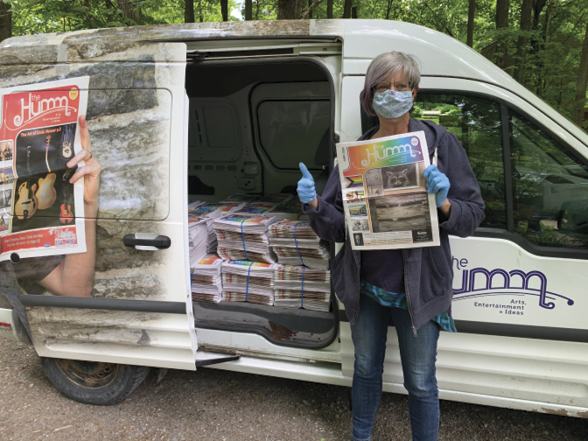
We’re heading out to deliver the June issue of theHumm! Because things have changed a wee bit since the last time we did our distribution, here’s a list of the places we will be trying to deliver to. Hours and more information can be found at the links. Happy Humm hunting!
Almonte:
Dandelion Foods <dandelionfoods.ca>
Don’s Meat Market <donsmeatmarket.ca>
Mill Street Books <millstreetbooks.com>
Almonte Antiques & Collectibles <facebook.com/Almonteantiquesandcollectibles>
General Fine Craft <generalfinecraft.com>
Hummingbird Chocolate <hummingbirdchocolate.com>
Sivarulrasa Gallery <sivarulrasa.com>
Baker Bob’s <facebook.com/BakerBobsAlmonte>
The Hub <thehubalmonte.com>
The Daily Scoop <thedailyscoop.ca>
Francis Fuels <francisfuels.com>
Heritage Court <heritagecourt.biz>
HFT Donuts <facebook.com/HFTinc>
Judy Joannou Designs <judyjoannoudesigns.ca>
Kehla Design <kehladesign.com>
Pêches et Poivre <pechesetpoivre.com>
Textile Traditions <facebook.com/TextileTraditionsOfAlmonte>
That’s the Spirit <facebook.com/ThatsTheSpiritAlmonte>
Carebridge Community Support <carebridge.ca>
Burnstown
Neat Café <neatmusicandcoffee.ca>
Bittersweet Gallery <burnstown.ca/bittersweet>
Carleton Place
The Good Food Co. <facebook.com/TheGoodFoodCo1997>
FreshCo <freshco.com/stores/carleton-place-lansdowne>
Eataria <facebook.com/pages/category/Restaurant/Eataria-Unlimited-495345314534157>
The Granary <granary.ca>
The Queen’s Craft Market <facebook.com/pg/thequeenscraftmarket>
Stalwart Brewing <stalwartbrewing.ca>
Temptations
Under Pressure <facebook.com/underpressurecoffeehouse>
Carp
Alice’s Café <alicesvillagecafe.com>
Carp Bakery <facebook.com/pages/Carp-Bakery/125977027499206>
Juke Joint Soul Kitchen <thejukejointsoulkitchen.com>
Ridge Rock <ridgerockbrewco.ca>
Pakenham
Centennial <centennialrestaurant.com>
Nicholson’s
Perth
Foodsmiths <foodsmiths.com>
The Book Nook <thebooknookperth.com>
The Riverguild <riverguild.com>
Strévé Design <strevedesign.com>
Mariposa Design <mariposadesign.ca>
Coutts Coffee <couttscoffee.ca>
Café Bean <facebook.com/Cafe-Bean-1432295620360603/>
Code’s Mill <codesmill.com>
Metro <metro.ca/en/find-a-grocery/326>
Perth Cheese Shop <theperthcheeseshop.com>
Pert Pie Co. / Artizen Kombucha <artizenkombucha.ca>
Westport
Kudrinko’s <kudrinkos.com>
Vanilla Bean’s <facebook.com/VanillaBeansWestport>
The Cove Inn <coveinn.com>